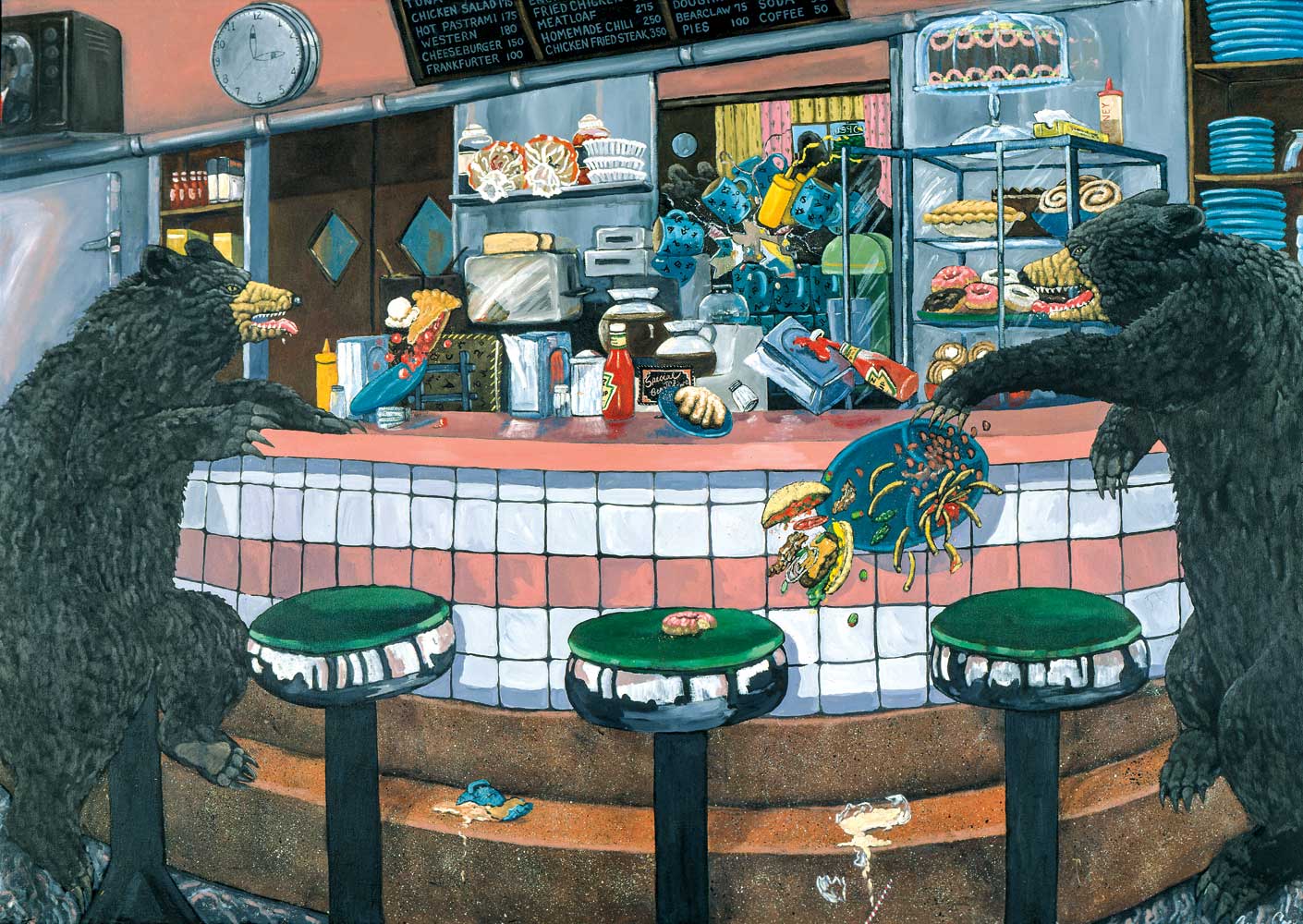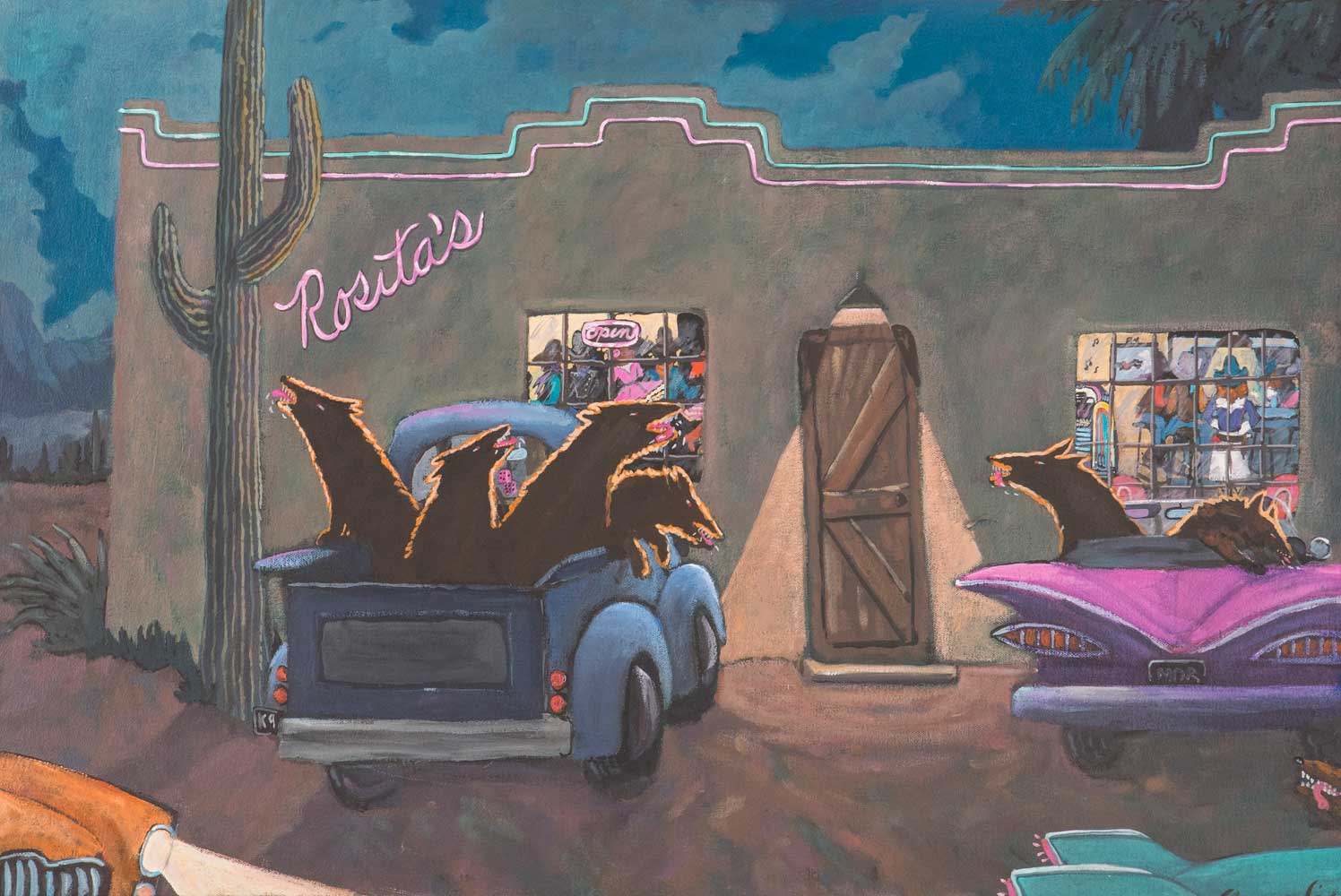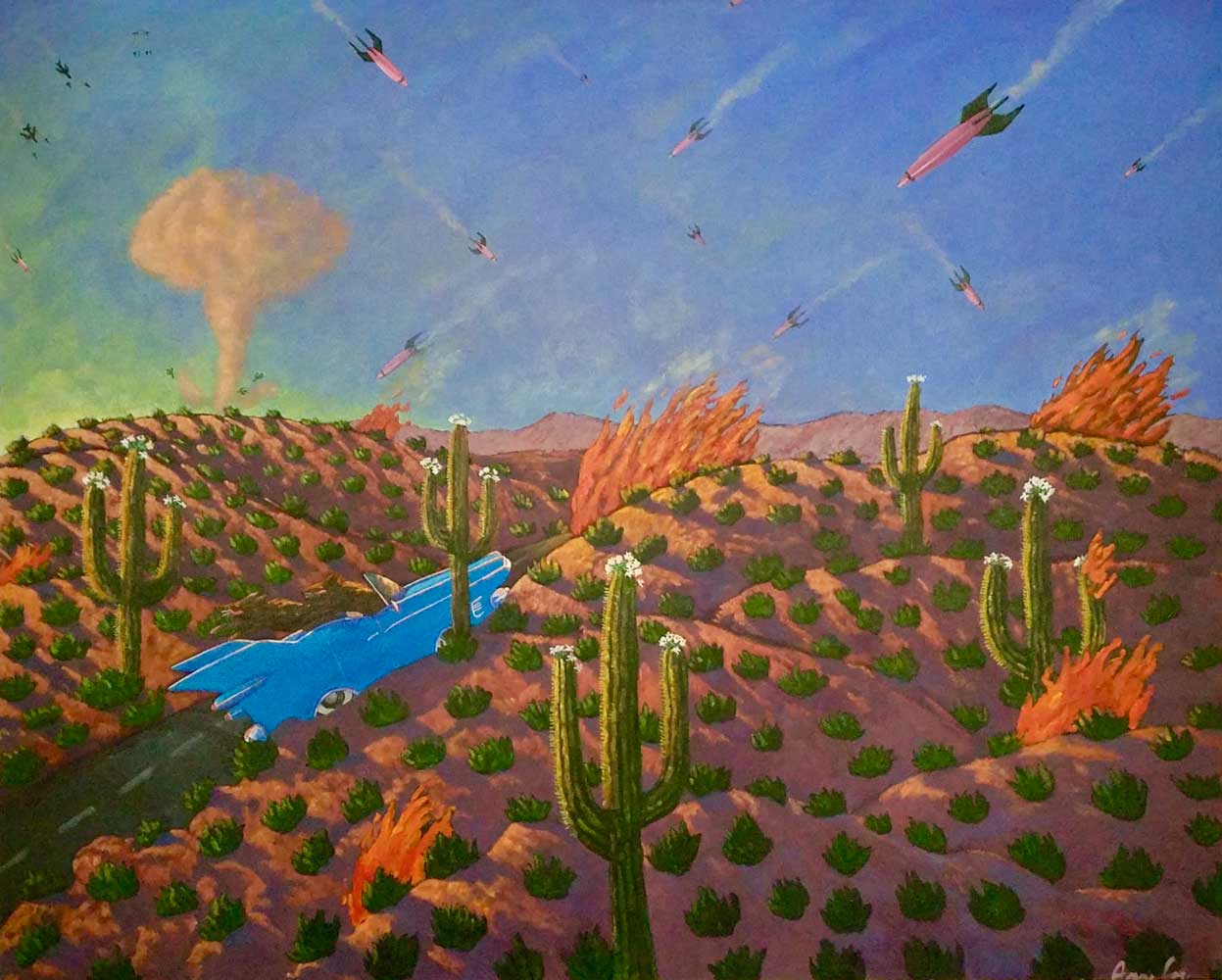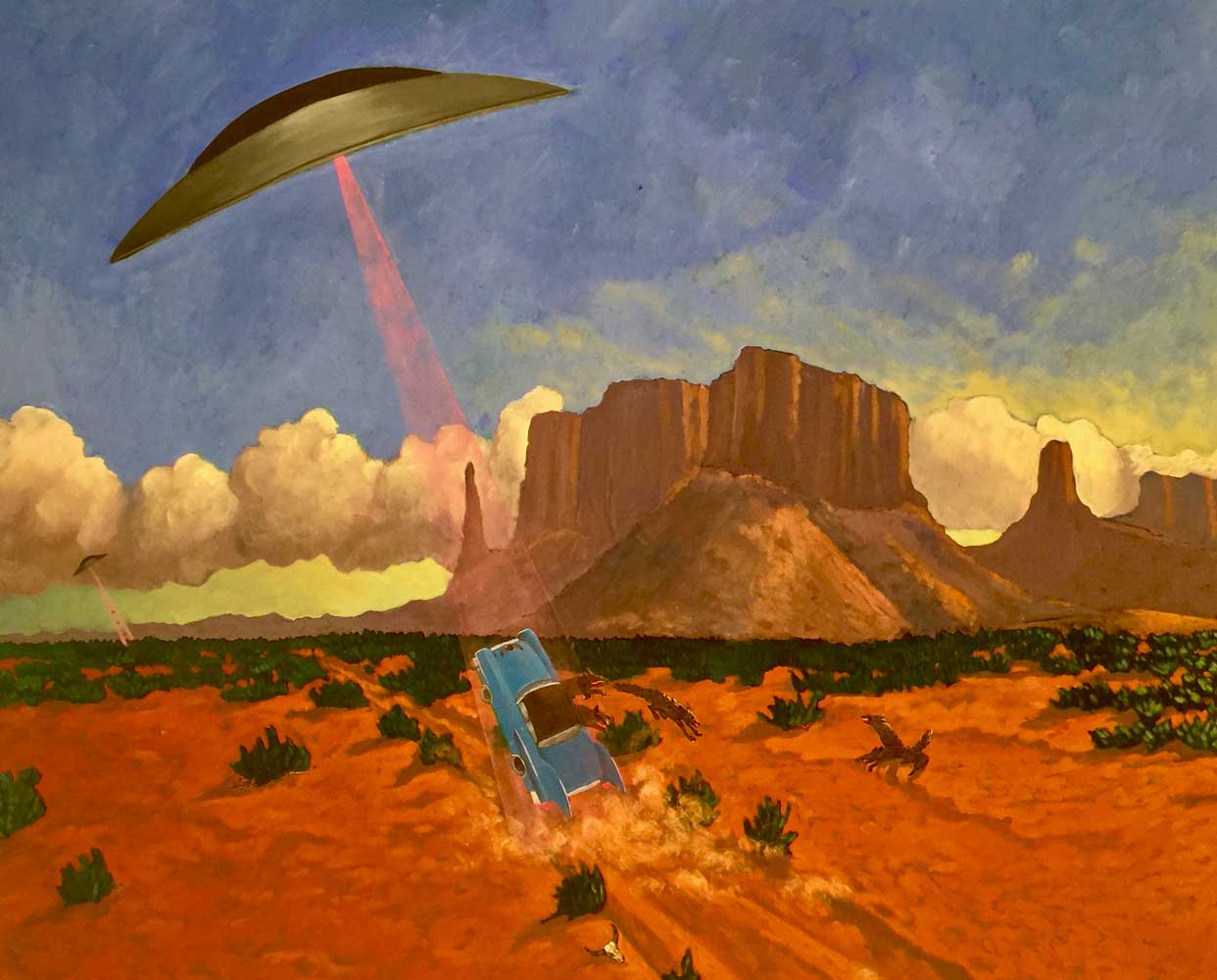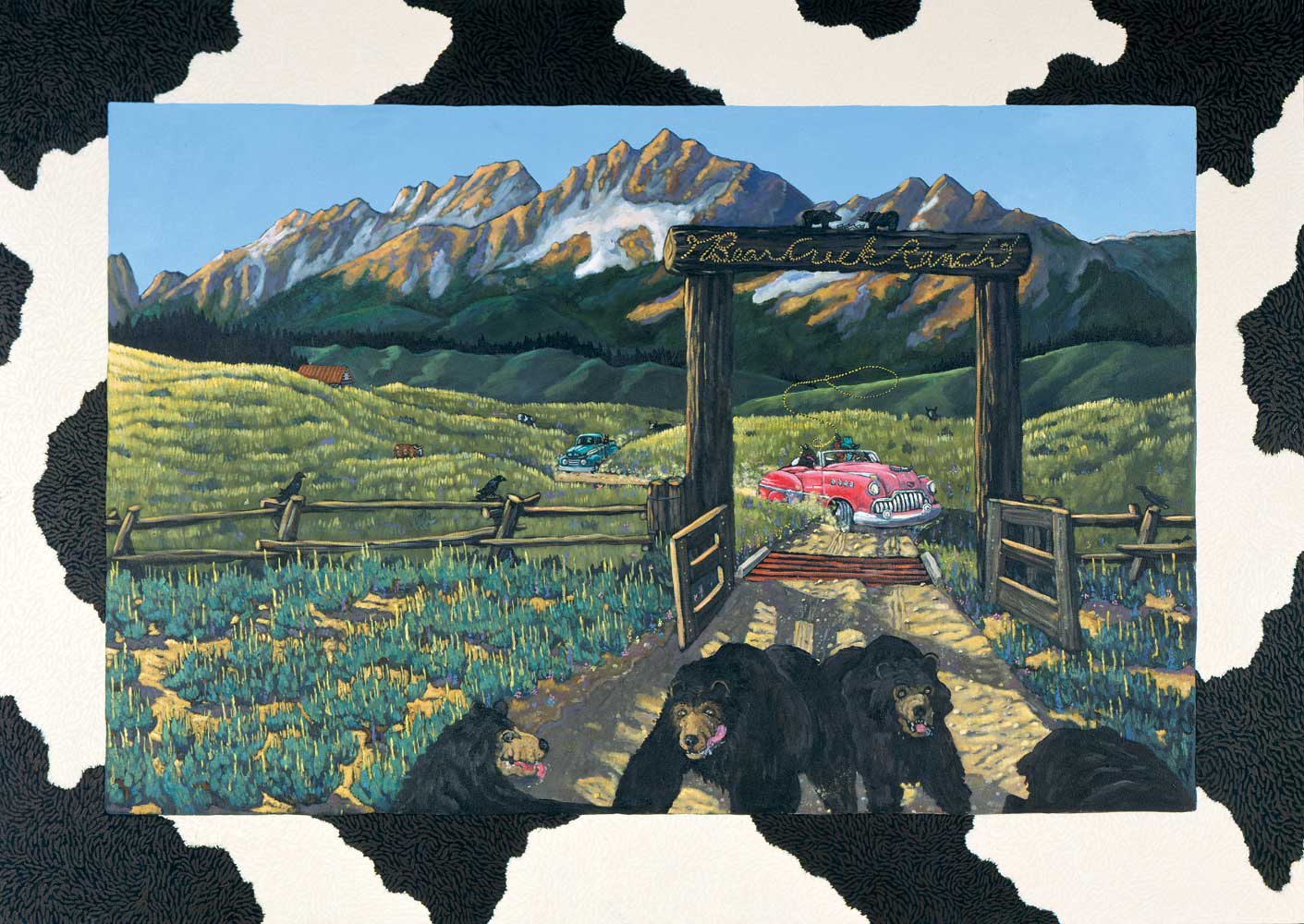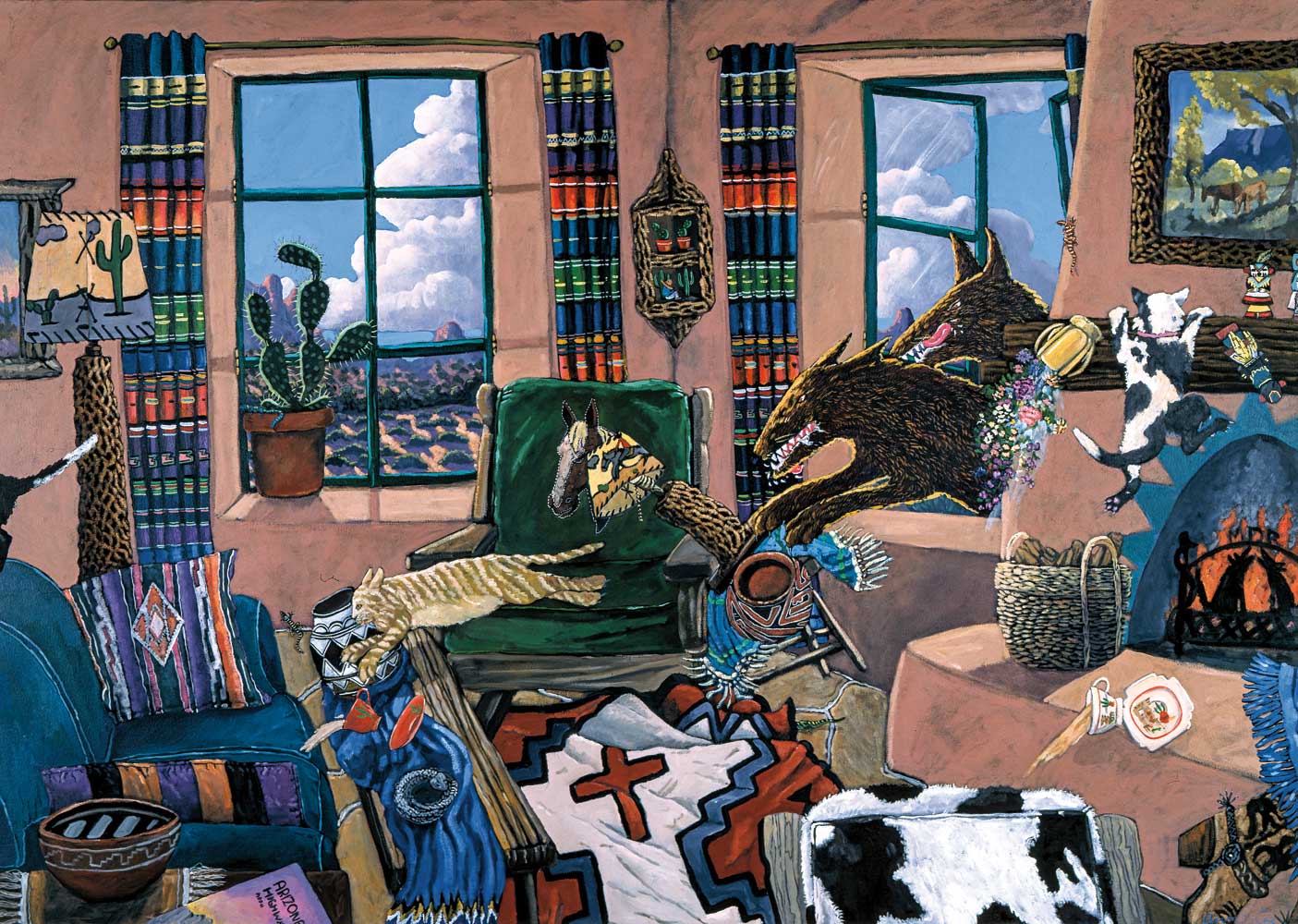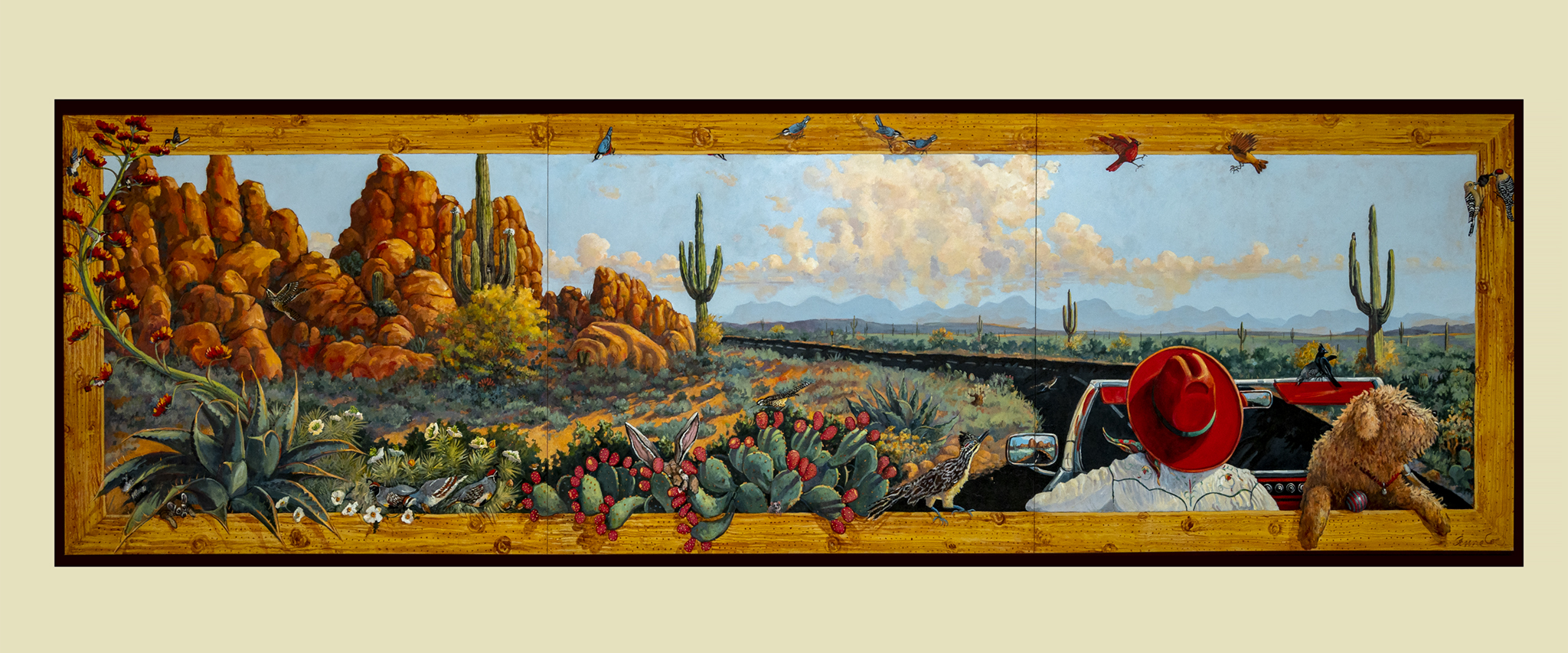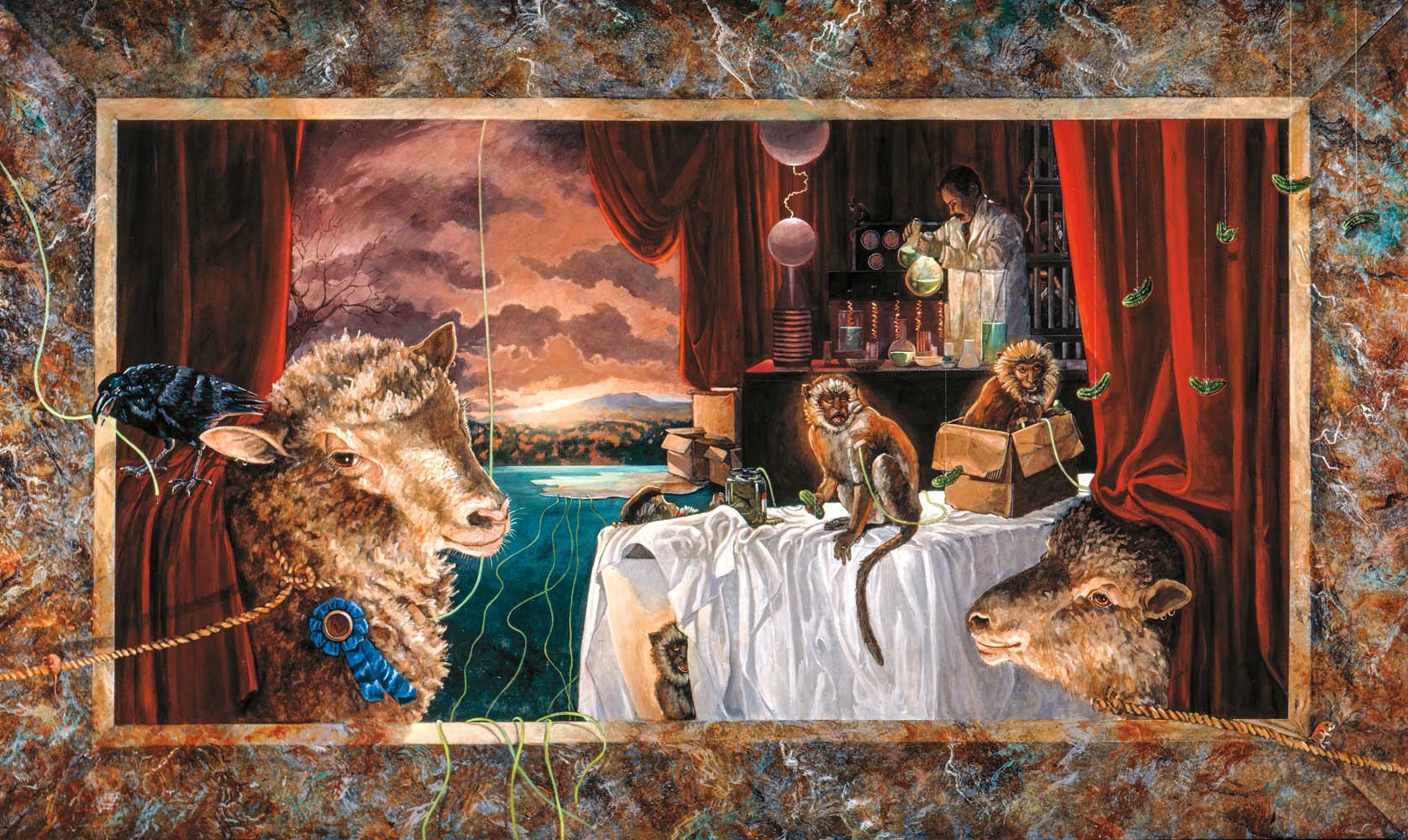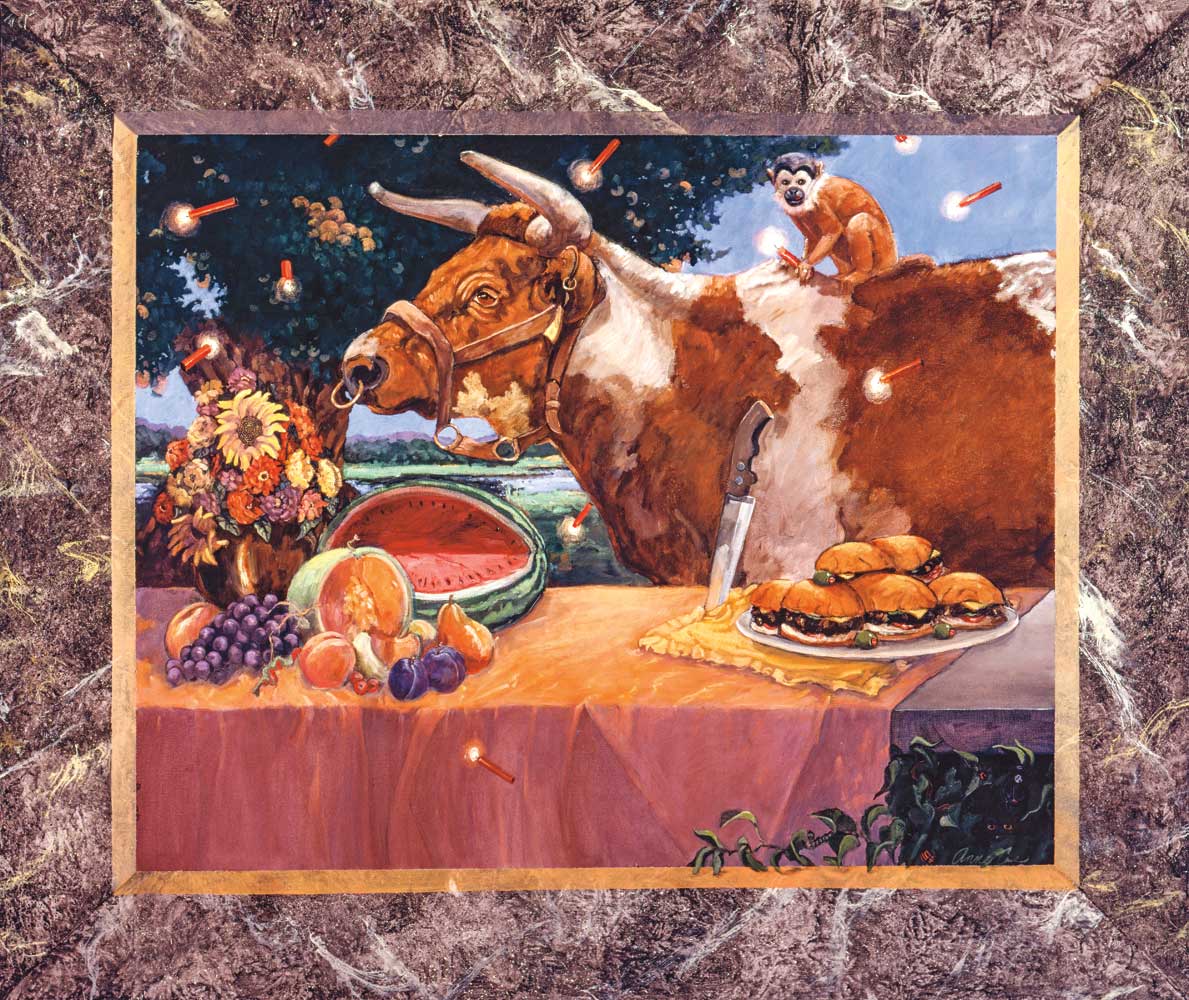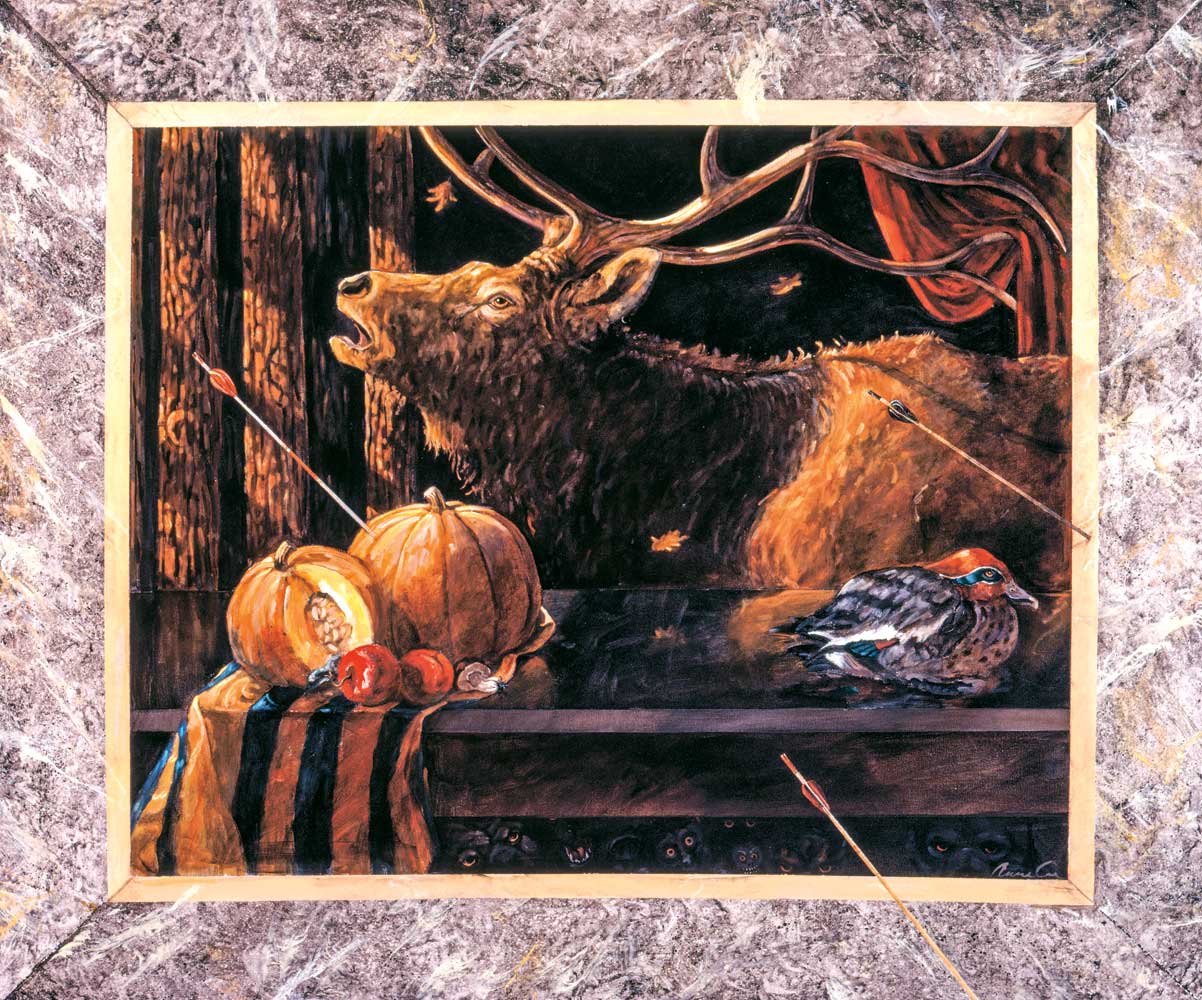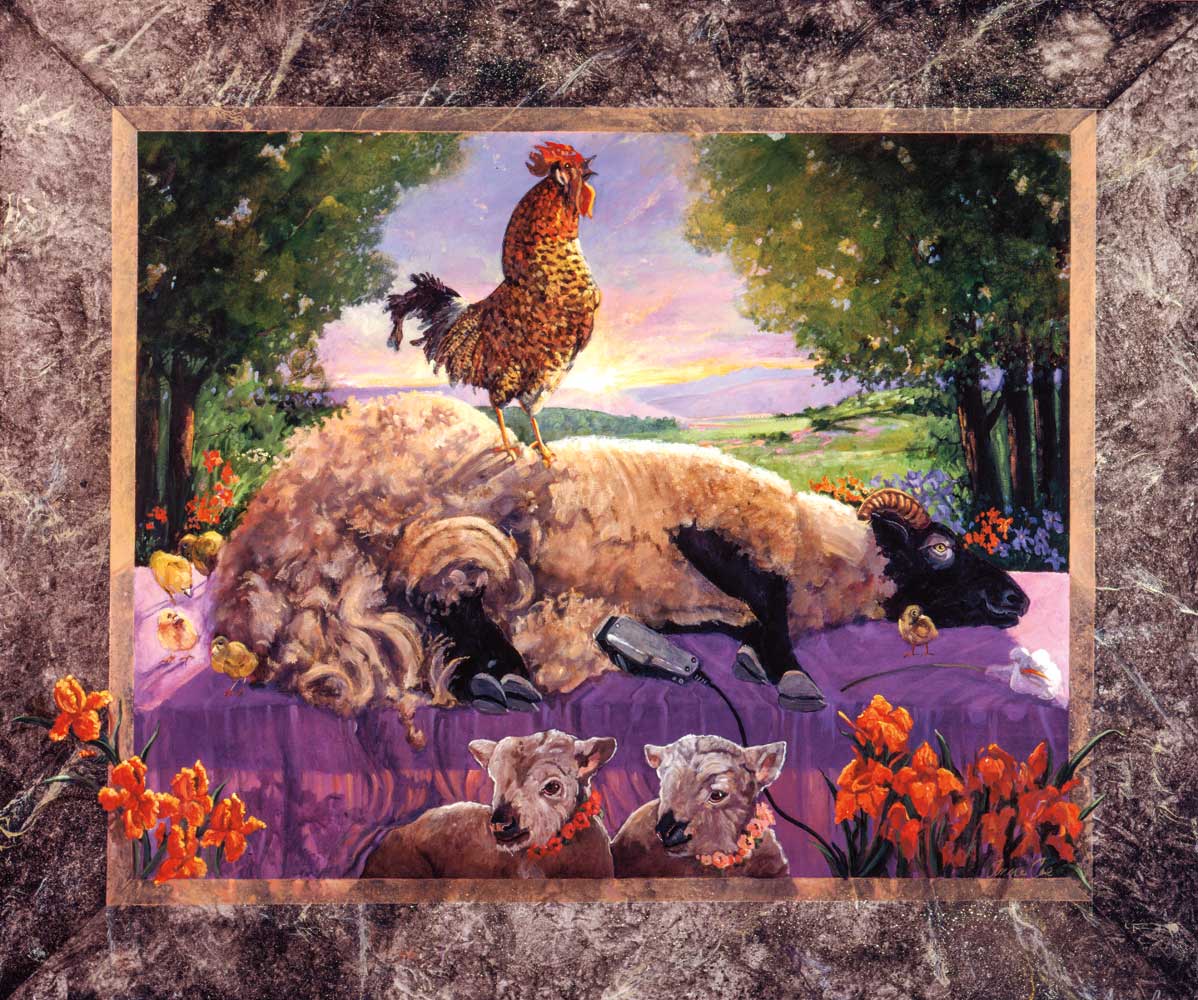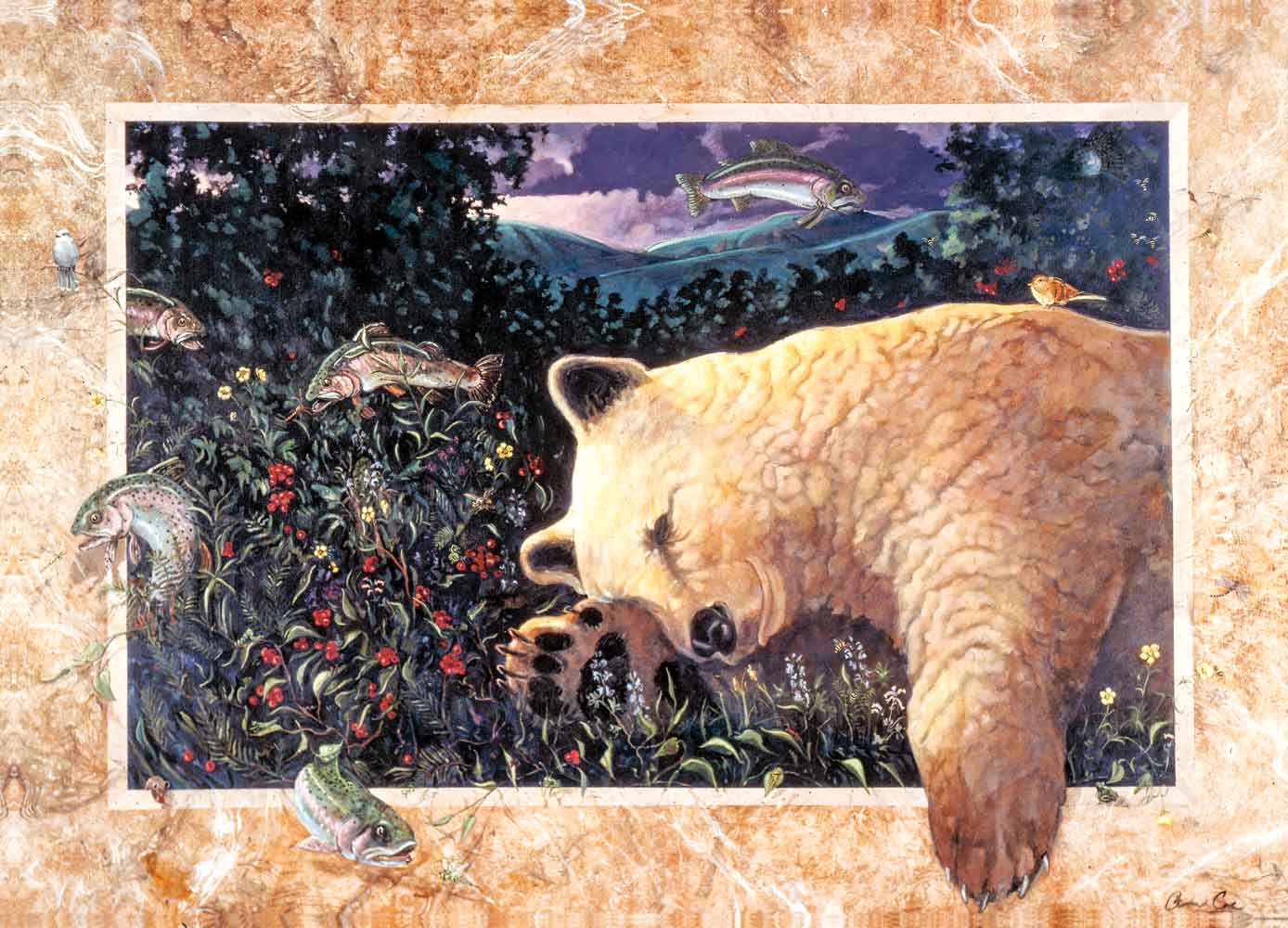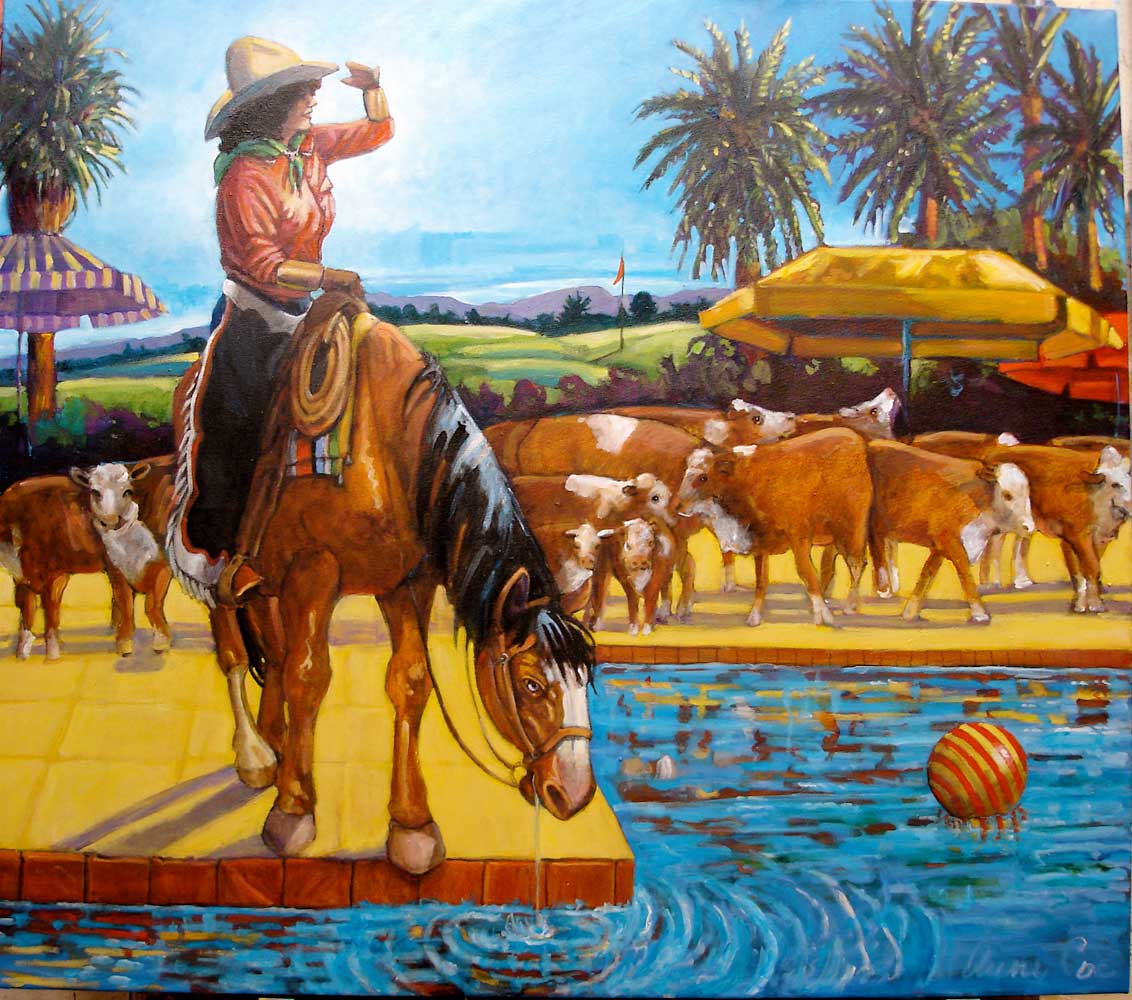MUSEUM OF ARIZONA ARTISTS
INVITES YOU TO TOUR THE
MOAZA DIGITAL MUSEUM
TRUE GRIT: ANNE COE’S WESTERN ART ODYSSEY
A “50 YEAR” RETROSPECTIVE
Curated by Julie Sasse, PhD, Chief Curator, Tucson Museum of Art – Bio
For fifty years, fourth-generation Arizonan Anne Coe (b. 1949) has created colorful and often whimsical paintings and works on paper that reveal a passion for the West with all its stereotypes, icons, and ironies. Just as importantly, she has created decades of powerful works that take a critical or revisionist stance, examining the clash of nature and society, asserting the cowgirl into the Western narrative, and addressing pressing environmental issues that are now known by such monikers as climate change and global warming. For trailblazing efforts in her approach to art of the American West and her masterful grasp of technique and artistic tenacity, it is fitting that the Museum of Arizona Artists (MOAZA) has selected Coe as its inaugural artist for an online solo exhibition in anticipation of a future, physical space…(read full essay)
View Anne Coe Video – MOAZA first Digital Museum Artist.
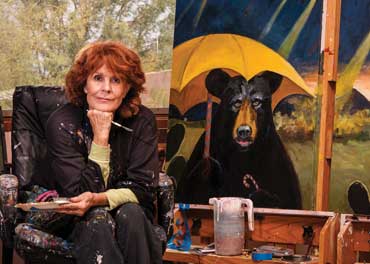
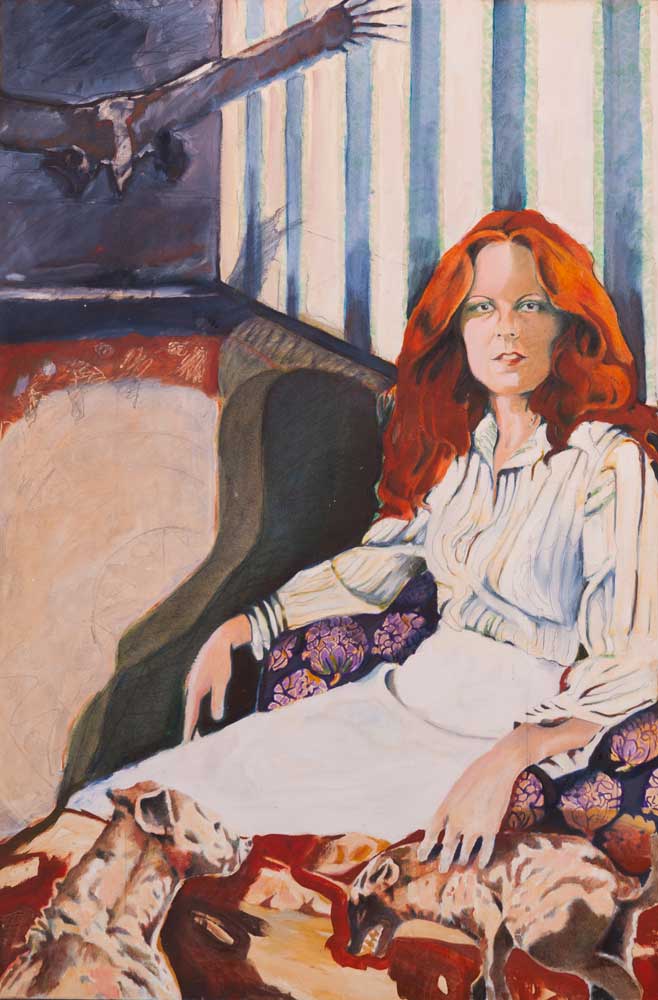
A poignant example of Coe’s feminist perspective on traditional themes can be seen in Annunciation (Self-Portrait), 1975. In this painting, Coe alludes to her teen pregnancy by using the religious allegory of the Annunciation. In the traditional story, the winged angel Gabriel, represented by a dove, appears before the Virgin Mary to announce that she will bear the son of God. In Coe’s painting, she places herself in the role of the Virgin Mary, dressed in white with her red curly hair flowing, her eyes cast directly to the viewer, commanding the viewers’ attention to her circumstance.
45 x 30”, Acrylic on Canvas
Another 1975 painting, Self-Portrait (with Wolf) focuses on the artist with her signature scarlet mane of curly long hair, wearing a provocative red dress in three different oblique poses against a gridded background, as if she is glancing downward at her reflection in a pool of clear water at her feet. A wolf is at her side like a totem animal, asserting her strong and independent spirit.
50 x 48”, Acrylic on Canvas
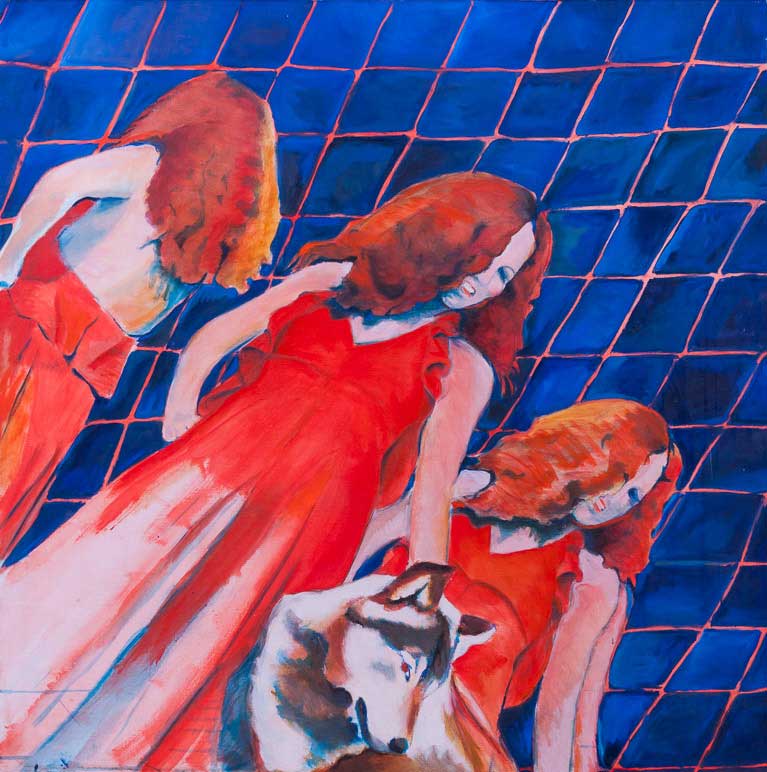
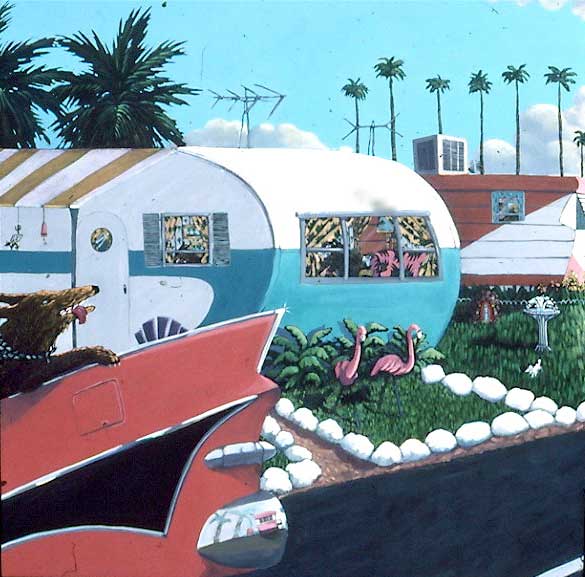
In one such painting, Escape from Dreamland Villa, 1982, Coe depicts a comical coyote seated in a vintage pink Cadillac convertible complete with large fins as it roars away from a turquoise and white motorhome. With so many of Coe’s works tinged on autobiography, the scene suggests childhood memories of animals and humans sharing uneasy desert terrain. At the same time, nostalgia for her childhood conflicts with the adult awareness of what overdevelopment can do to the desert.
48 x 48”, Acrylic on Canvas
A classic example of Coe’s adept melding of humor and wisdom can be seen in Counter Culture [sic], 1980, a display showing two black bears that have invaded a 1950s-era diner, complete with vinyl-covered swivel stools and a Formica countertop. Commenting on the disastrous results when humans continually overdevelop raw nature and encroach on the habitat of wildlife, Coe presents the slobbering bears as running amok in the empty diner.
29 x 39”, Acrylic on Canvas
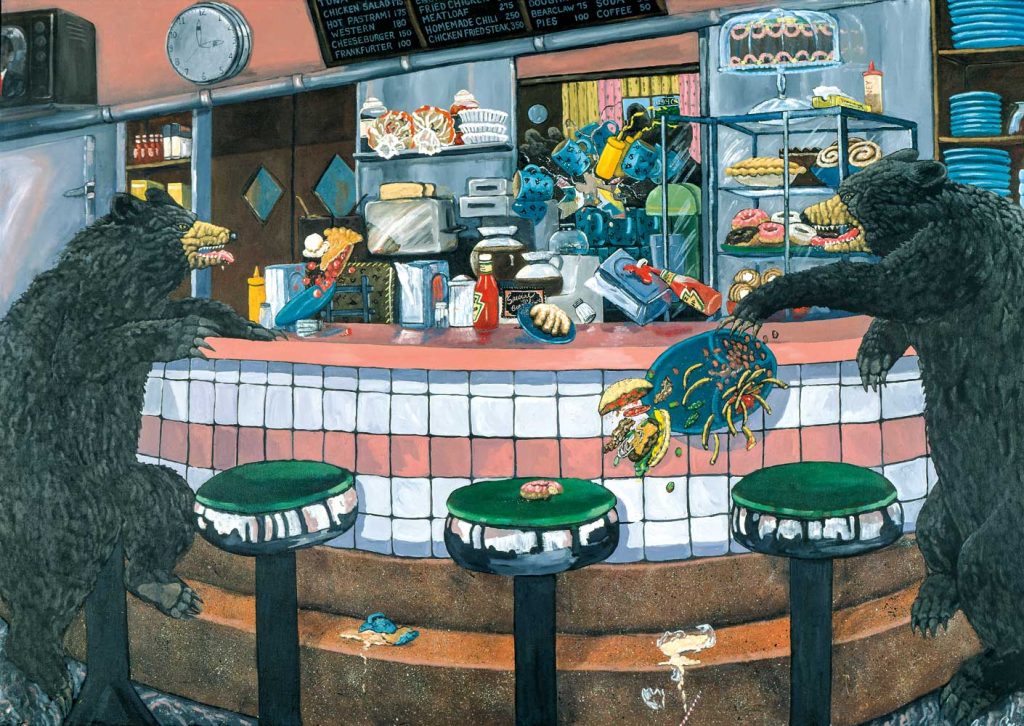
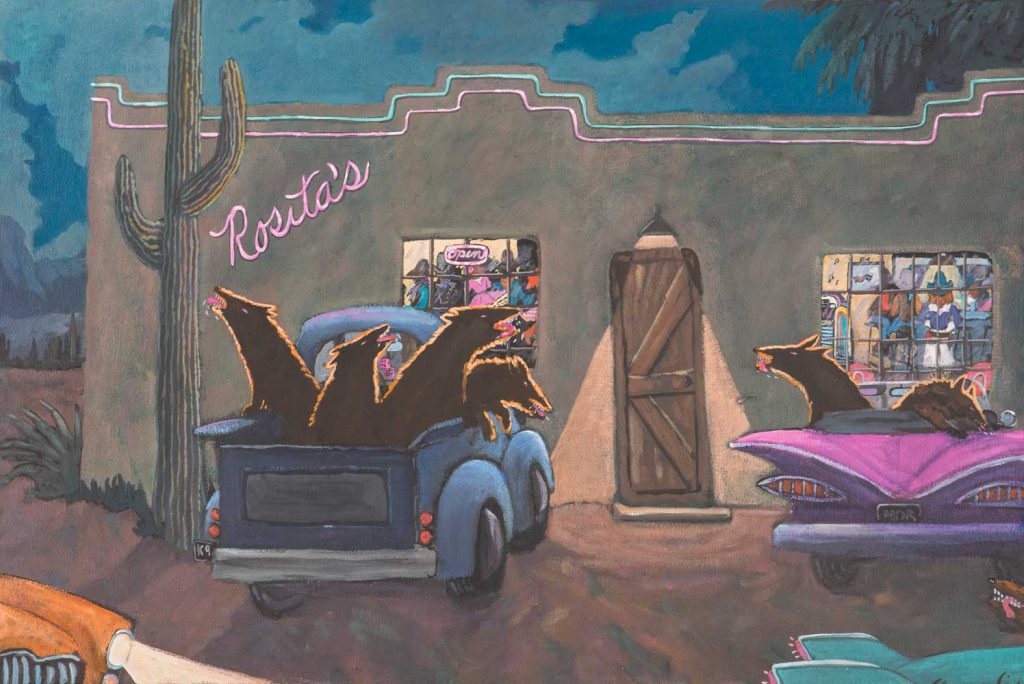
Among the unique themes that Coe explored is a nocturnal fantasy entitled Rendevous [sic] at Rosita’s, 1983, where frisky behavior is about to take place at a Southwest roadhouse, inspired by the cheap motels that operated on the outskirts of the Wellton from her childhood. In this painting, four coyotes with teeth bared and spewing drool are about to disembark a vintage pickup truck for Rosita’s, a honkytonk filled with tricked-out cowgirls and cowboys.
40 x 30”, Acrylic on Canvas
The ranch reference is seen again in Mad Dog Ranch Roundup, 1983. In this dynamic painting, Coe portrays herself as a punk cowgirl in sunglasses and a black hat, racing down a dusty road in a blue vintage Cadillac convertible toward the entry arch to the Mad Dog Ranch.
30 x 50”, Acrylic on Canvas
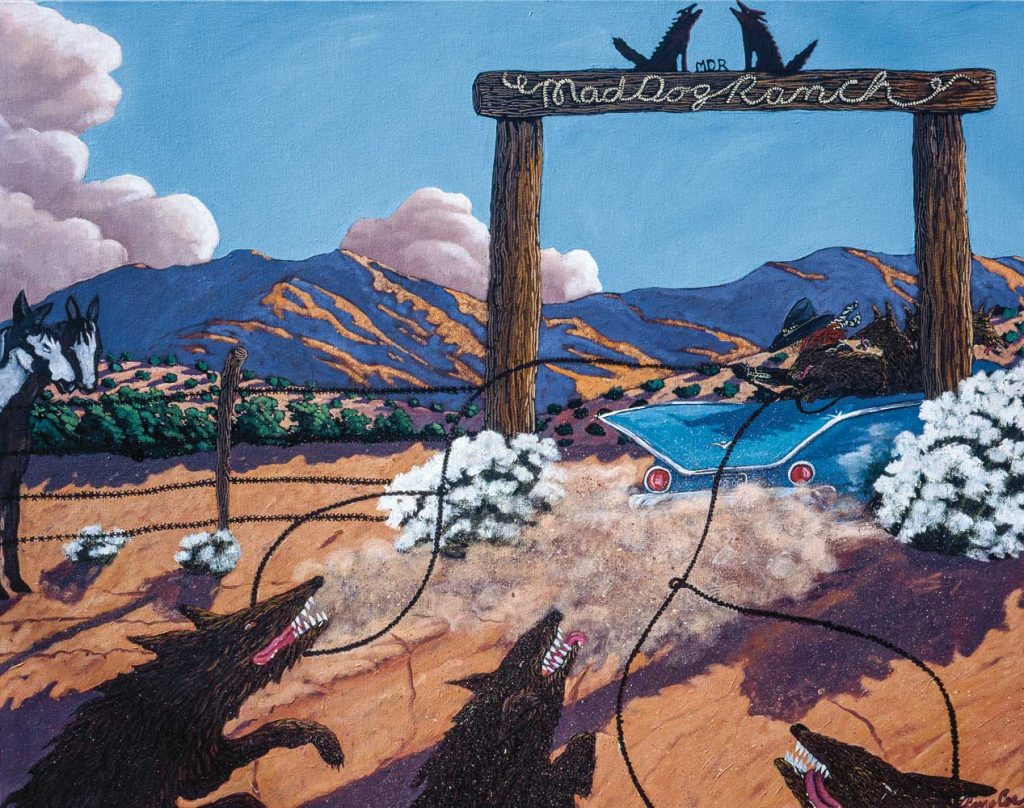
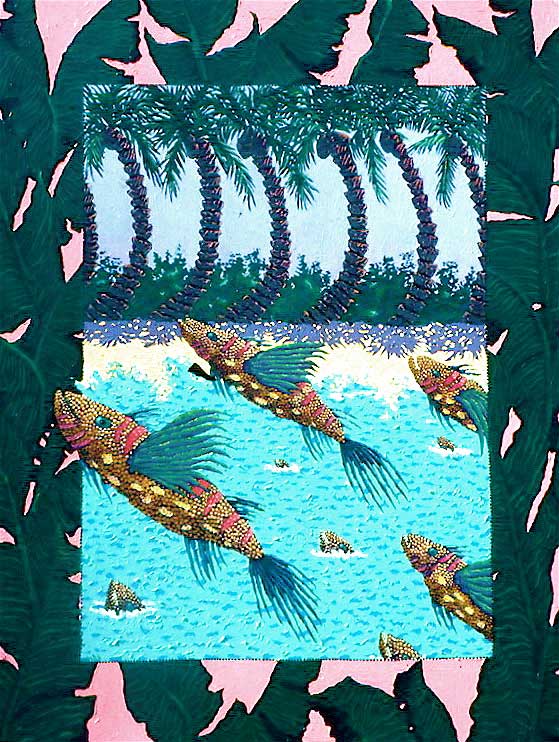
Still relying on wordplay to establish the scene, she created the lively On the Road to Mandalay Where the Flying Fishes Play, 1983, a light-hearted painting that expresses the pure joy of a day on the beach in a tropical setting. Using her signature faux framing illusion developed during graduate school, Coe encloses her seascape in a pattern of dark green foliage against a pink background.
1983, 50 x 40”, Acrylic on Canvas
Revealing of Coe’s acerbic wit, in 1983 she painted An Otherwise Quiet Day in the Bermuda Triangle, in which a throng of coyotes’ frolic in the surf or sunbathe on colorful beach blankets while, in the distance, three large water tornadoes appear to be sweeping up various sea life from the ocean, including sharks, whales, octopi, and the occasional sailboat.
1983, 50 x 50”, Acrylic on Canvas
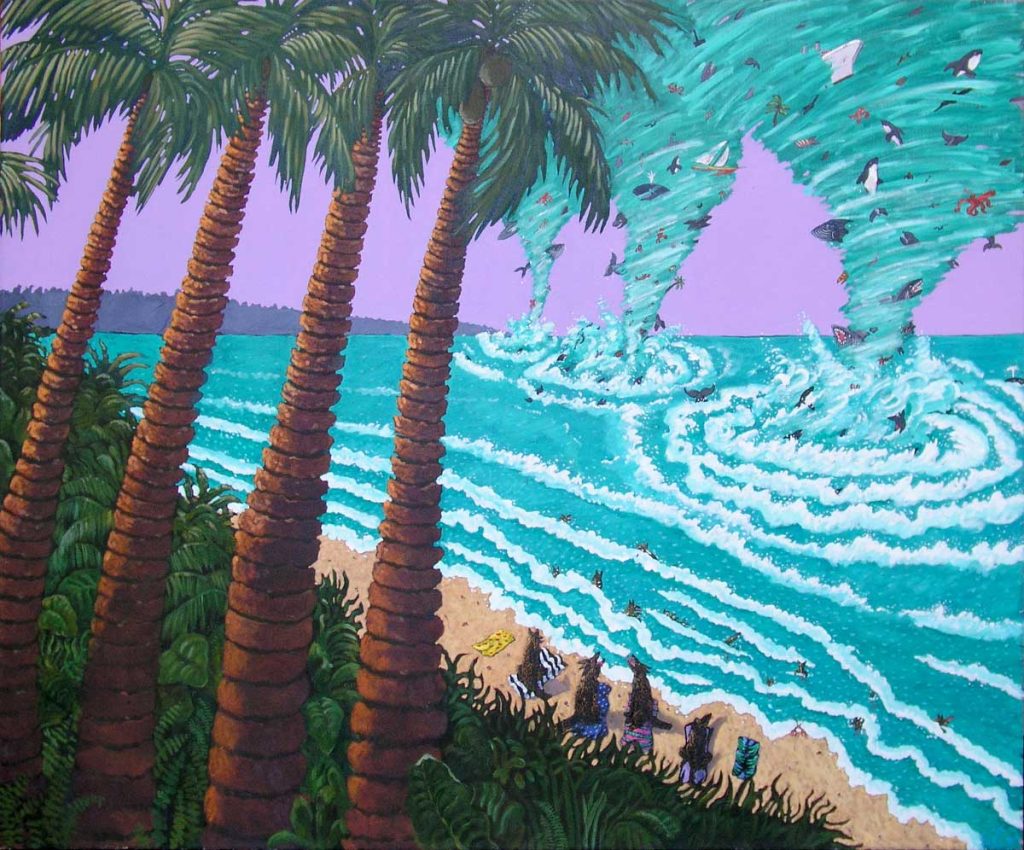
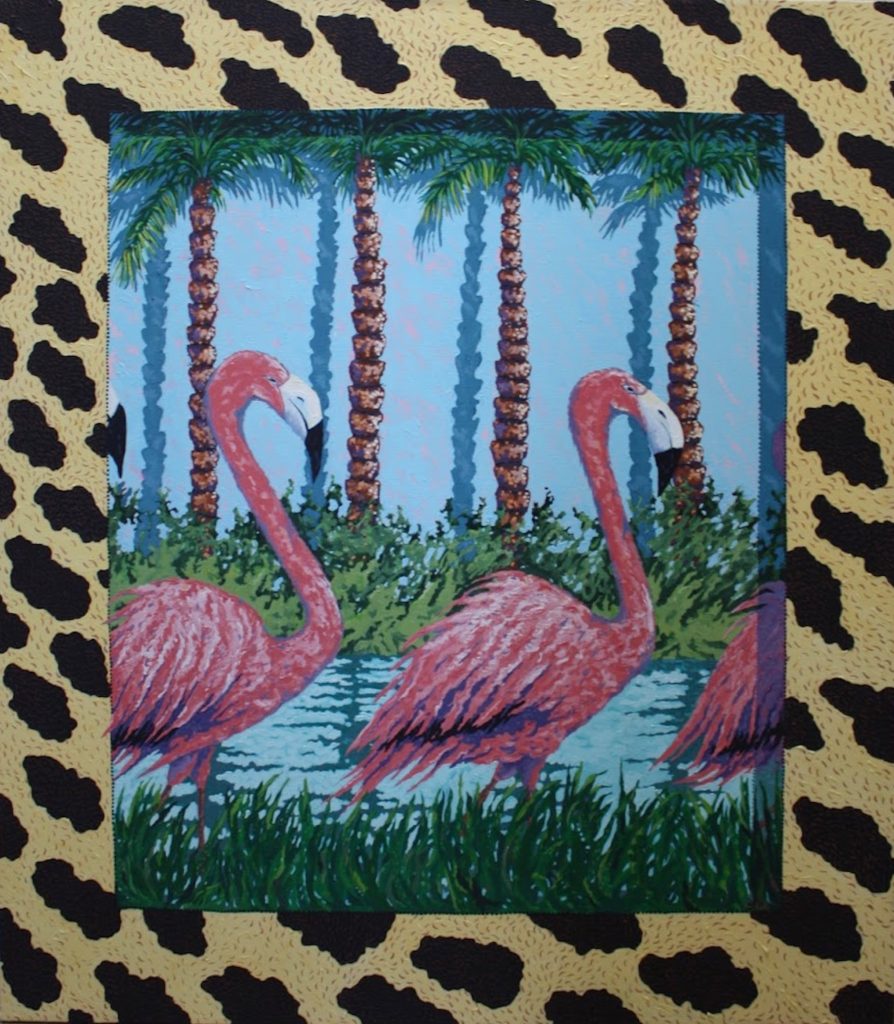
She also created Flamingo Phile, 1984, which became part of the Betty Barber-Hughes and Jerry D. Barber collection, later to become the Jerre Lynn Vanier collection. Set within a yellow and black-patterned frame, three pink flamingos wade through water in single file across the tropical scene, as if marching across a stage.
45 x 30”, Acrylic on Canvas
Comically playful and deadly serious, Coe sends messages about humankind’s out-of-control energy needs amid a fragile ecosystem. For example, in Migrating Mutants, 1983, she portrays four of these orange and black-speckled beasts in a gargantuan scale. Exposing rows of sharp, pointed teeth and long, pink tongues, the gigantic lizards roar with laughter as they lumber through the pristine desert, smashing power lines and saguaro cacti on their trek through the landscape.
50 x 50”, Acrylic on Canvas
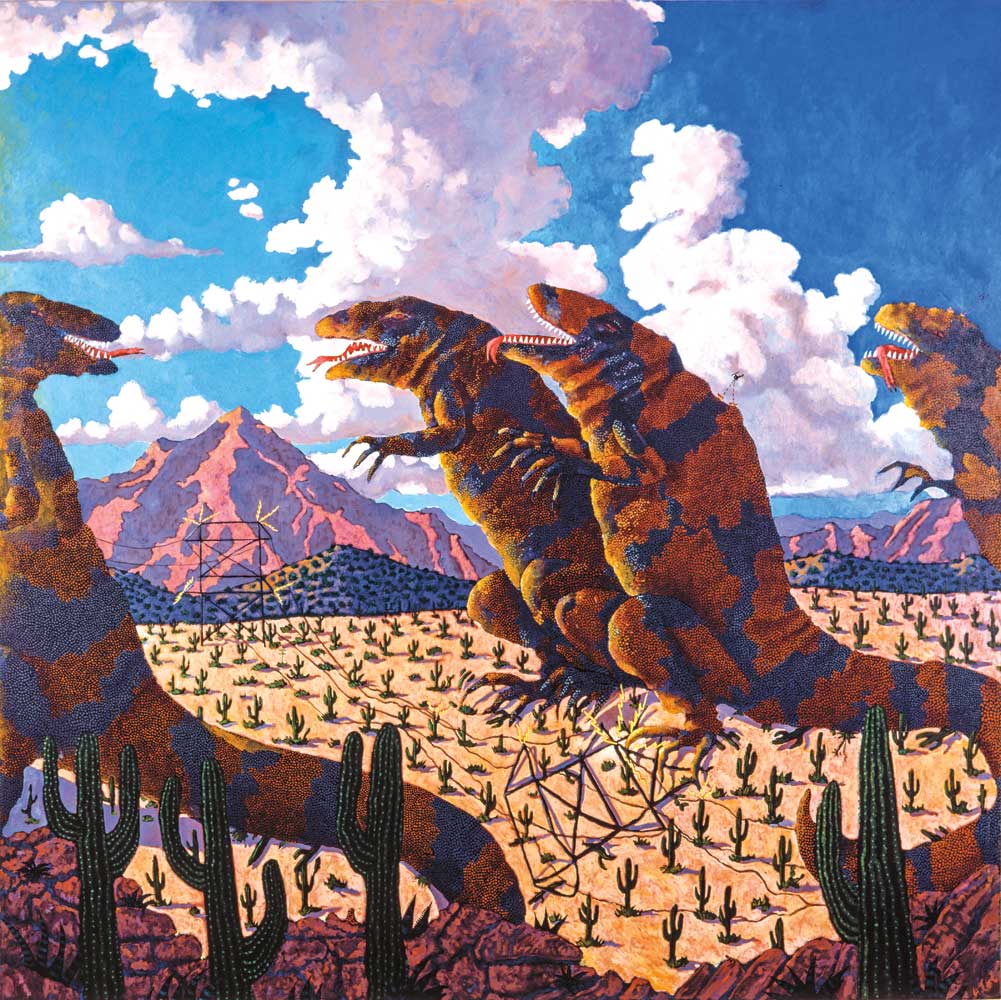

In a later rendition of this series, Another Western Water Project, 1989, a steady stream of motor homes, vintage trucks, and cars climb up a steep single-lane road to the top of a dam in the Sonoran Desert dotted with colorful cacti. What would be remote wilderness is made into a tourist destination by the human-made lake made by the dam. But the tourists’ plans are about to be dashed as an enormous Gila monster has entered the edge of the lake and destroys the dam…
45 x 45”, Acrylic on Canvas
Coe explores the irony of the juxtaposition of gunnery range and wildlife refuge, seeing airplanes flying overhead, artillery fire, and scurrying animals. She depicts such childhood memories in Yuma Range, 1984, a twilight scene in the remote part of the Sonoran Desert where two coyotes take a joyride in her signature blue vintage Cadillac convertible that barrels through the desert on a two-lane road to escape a network of fires.
40 x 50”, Acrylic on Canvas
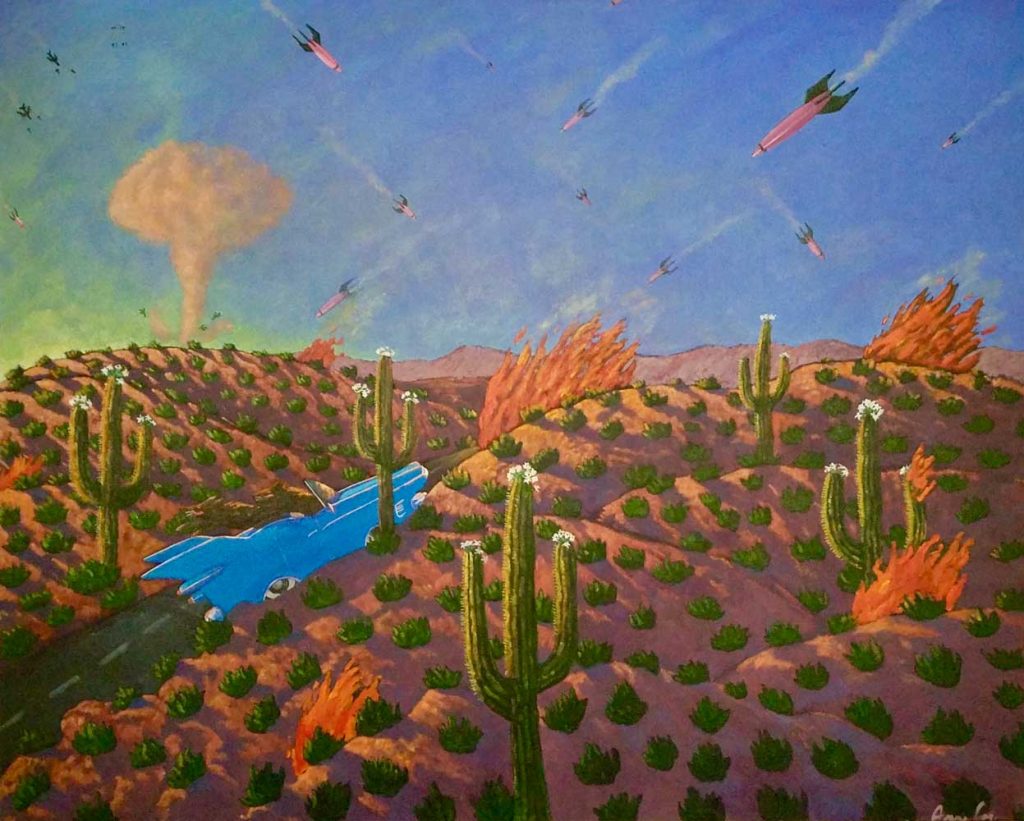
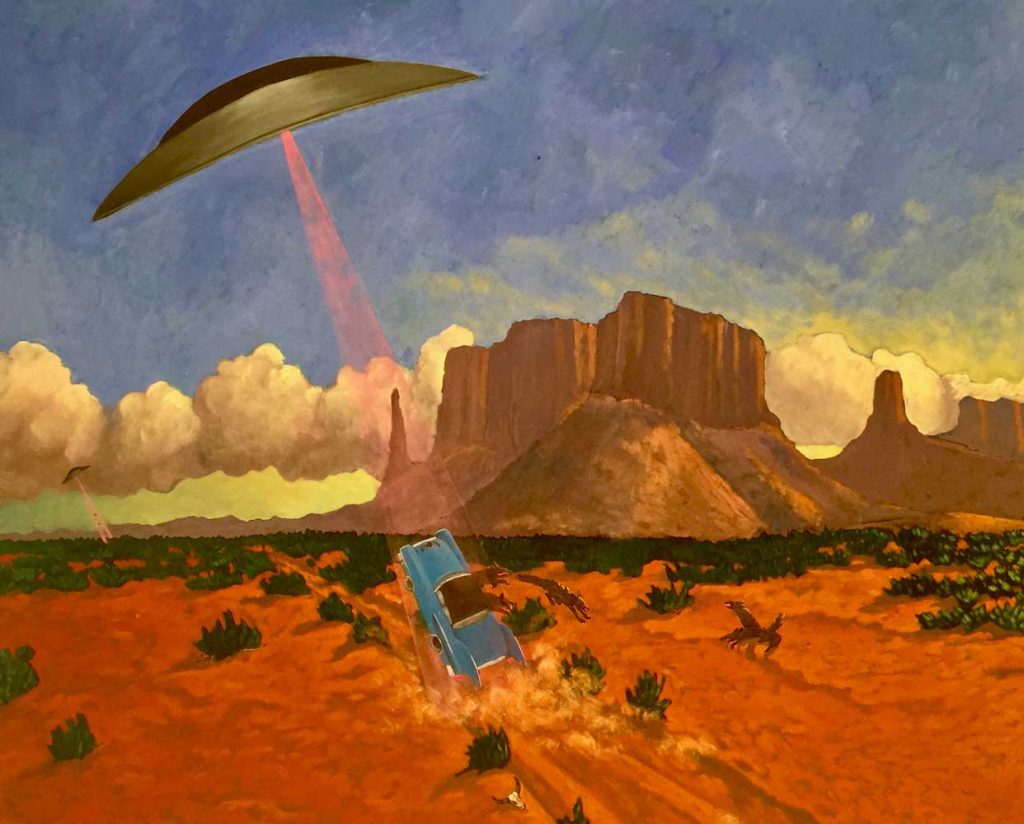
One of Coe’s first UFO works is Road Hazards UFO, 1984. The setting of this painting is a classic western landscape, presumably Monument Valley, with billowing clouds at dusk. What interrupts the traditional scene, however, is the element of humor.
45 x 45”, Acrylic on Canvas
Spending summers in Jackson Hole, Wyoming, where Schenck built a cabin next to the Grand Tetons, Coe painted landscapes and subjects of northwestern Wyoming with mountains, trout streams, tall pines, grizzly bears, and self-portraits as an assertive cowgirl. For example, in Roundup at Bear Creek, 1986, Coe creates a new fictional space in a majestic landscape called the Bear Creek Ranch.
50 x 70”, Acrylic on Canvas
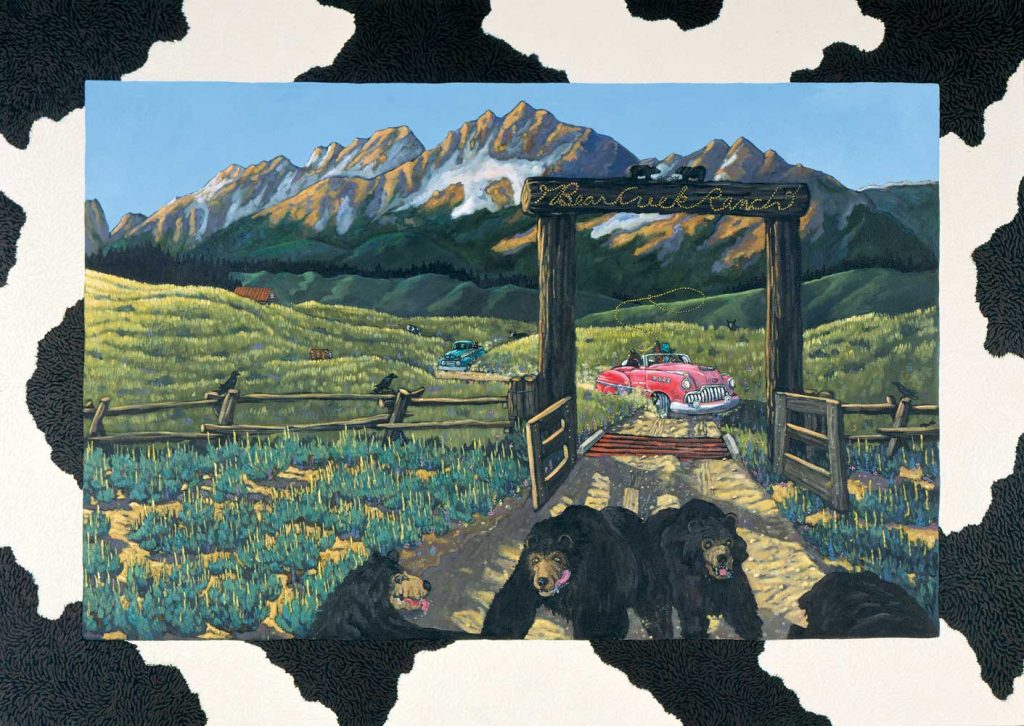
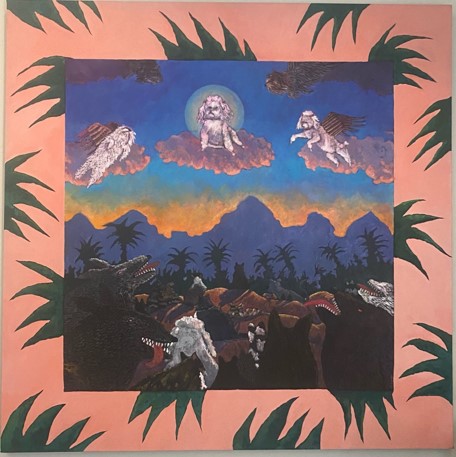
In the mid-1980s Coe accepted commission work while creating several bodies of new work as well. One such commissioned project was The Ascension, 1986, created as a tribute to Jerry D. Barber, Jerre Lynn Vanier’s father, who had recently passed away in 1985 from a long illness, to be given as a gift to her mother, Betty Barber Hughes.
50 x 50”, Acrylic on Canvas
Perhaps as a nod to the changes happening in Coe’s personal life, she painted Domestic Crisis, 1989, revealing a chaotic scene of wild nature versus domestic order. The painting is set within a classic adobe home complete with Southwest interior décor popular at that time.
50 x 70”, Acrylic on Canvas
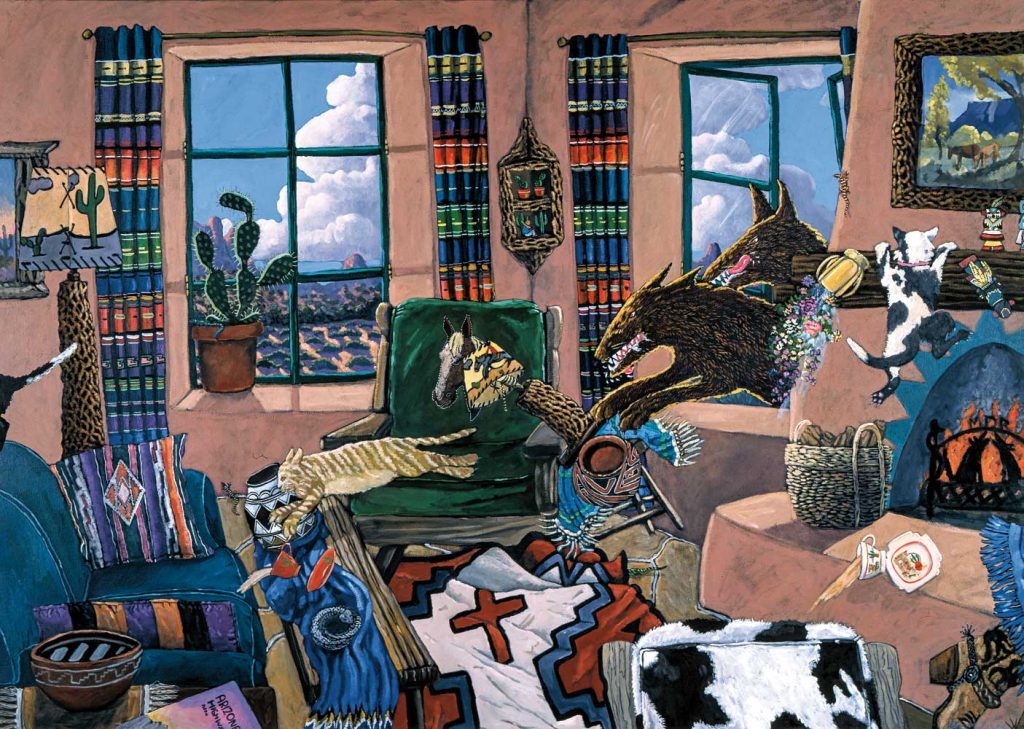
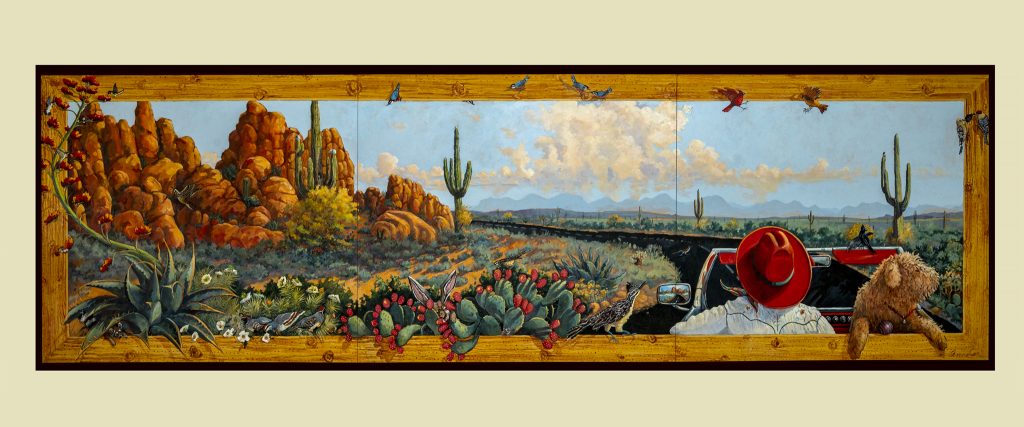
45 x 70”, Acrylic on Canvas
Coe’s intelligent humor and mastery of her medium can be seen at its best in Seven Deadly Sins: Gluttony, 1992, a compositional format inspired by fifteenth-century Dutch master Jan van Eyck’s Madonna of Chancellor Rolin.Coe consciously mines such sources, declaring, “I’ve always looked at medieval art for guidance.
72 x 60”, Acrylic on Canvas
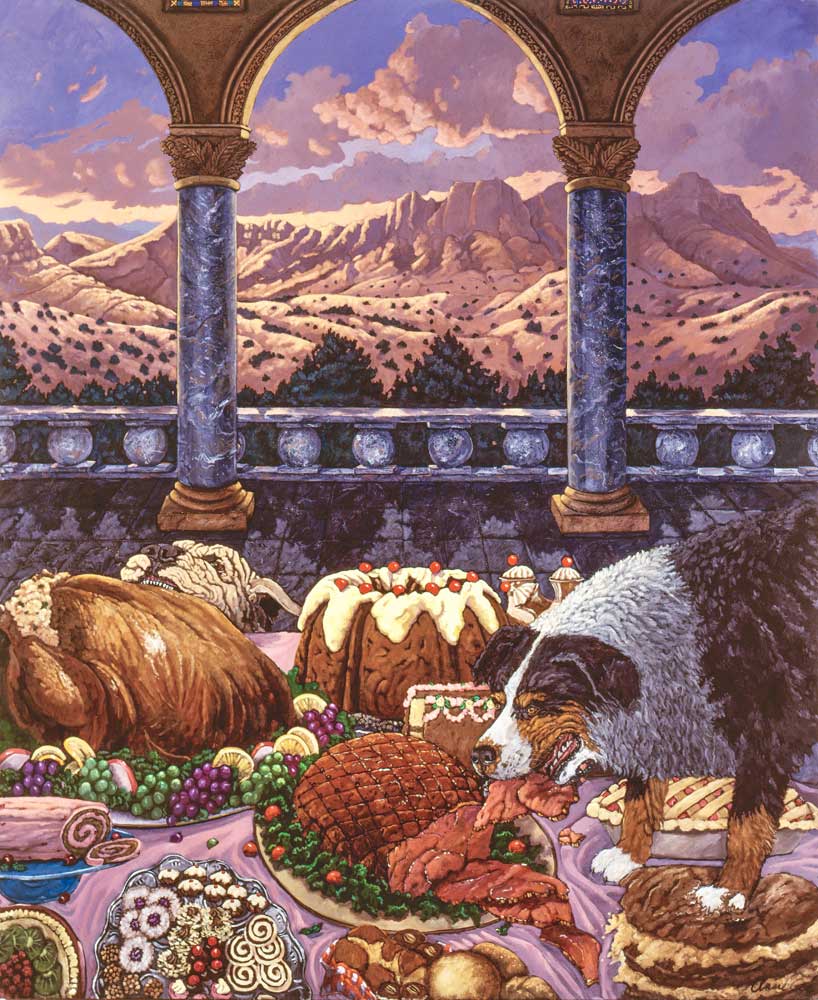
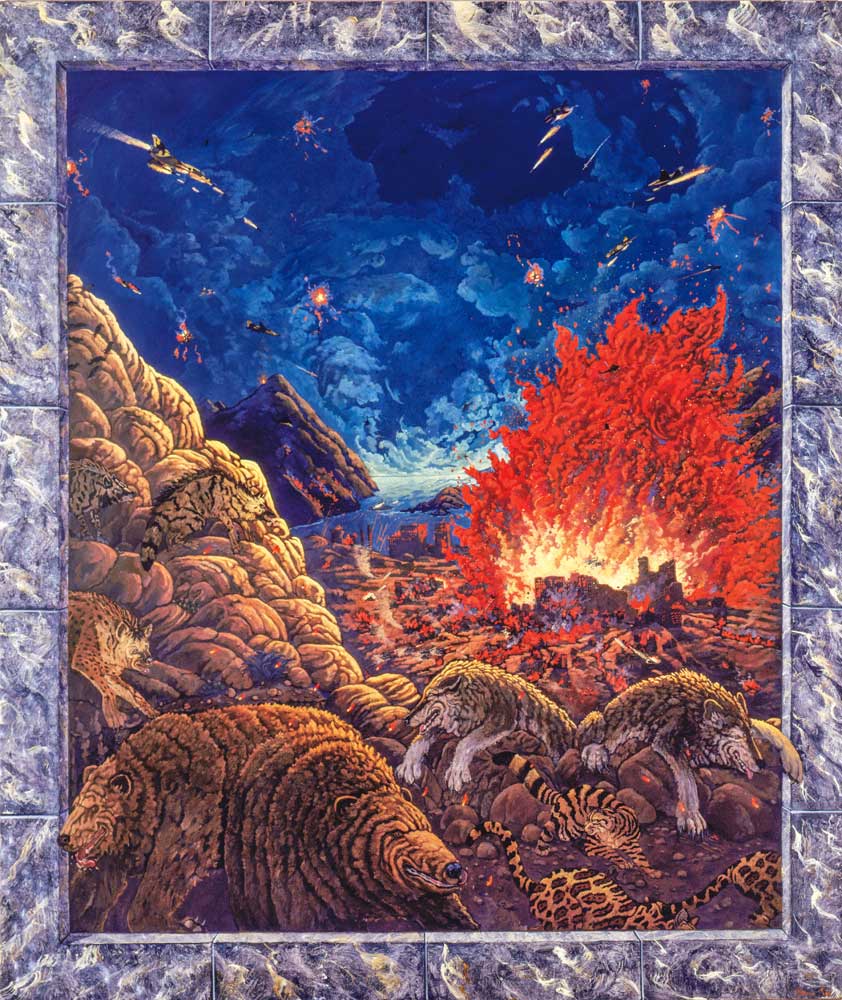
A more pointedly environmentalist message can be found in Seven Deadly Sins: Wrath, 1992. Enclosed in her signature trompe l’oeil frame, Coe sets the scene of a tumultuous dark sky and high vantage point of a city below and a sea in the far background.
72 x 60”, Acrylic on Canvas
One of the most dramatic of the series of the same name is Life Examined, 1998, a large dark canvas that is framed in Coe’s classic faux marble treatment with small details extending into the frame to remind the viewer it is only an illusion.
60 x 100”, Acrylic on Canvas
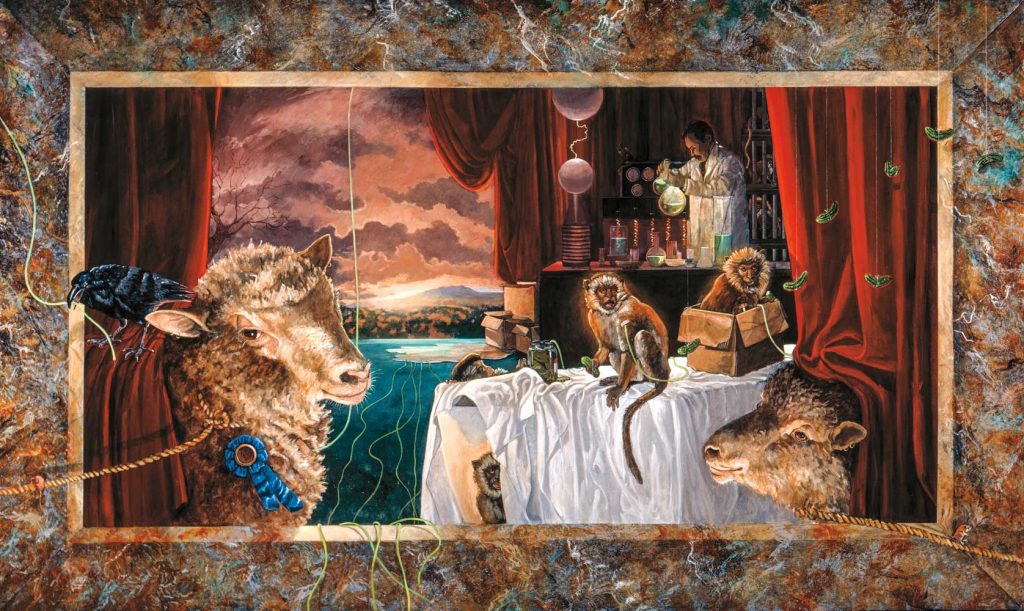
As part of the 1998 version of “Life Examined,” Coe presented the series “Still Life: The Four Seasons”
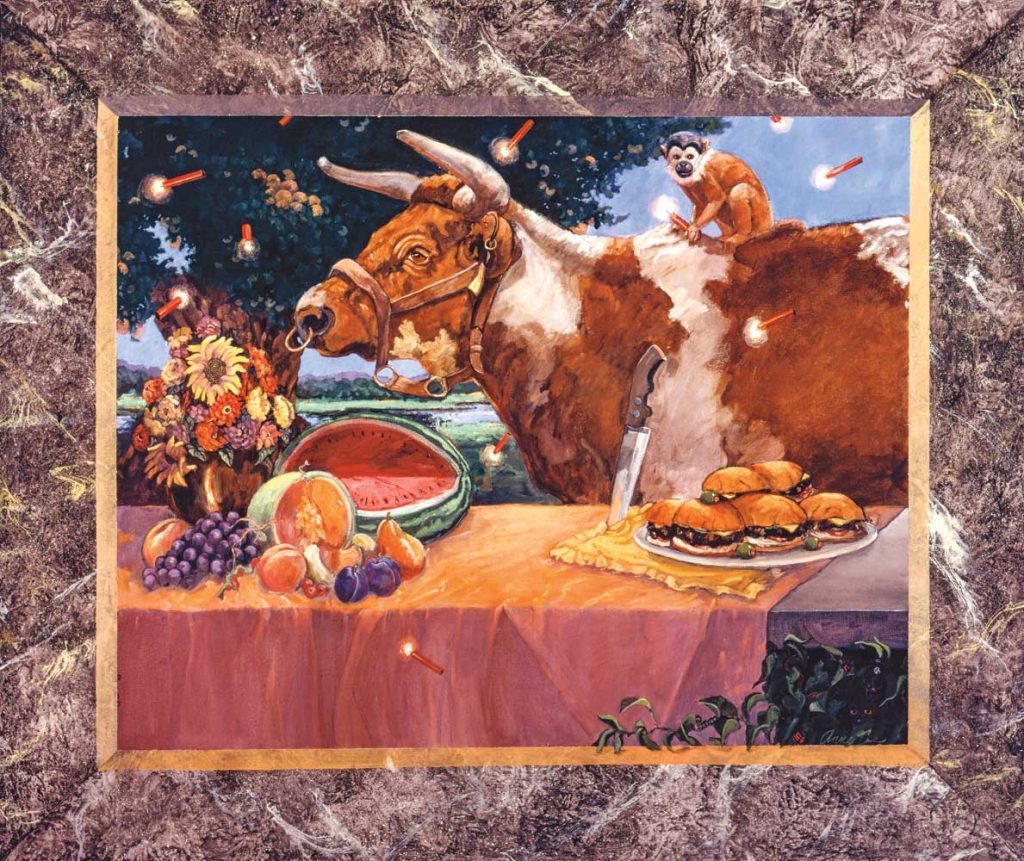
Still Life—Summer is the most uplifting. In this work, a large cow, with a harness and nose ring to indicate its domesticity, ambles across the picture plane with a monkey riding on its back.
44 x 52”, Acrylic on Canvas
Still Life—Fall is dramatically lit and reminiscent of a classic nature mort painting. Within an illusionistic frame, a braying stag anticipates death, surrounded by arrows that have landed on a pumpkin and the edge of the composition itself.
44 x 52”, Acrylic on Canvas
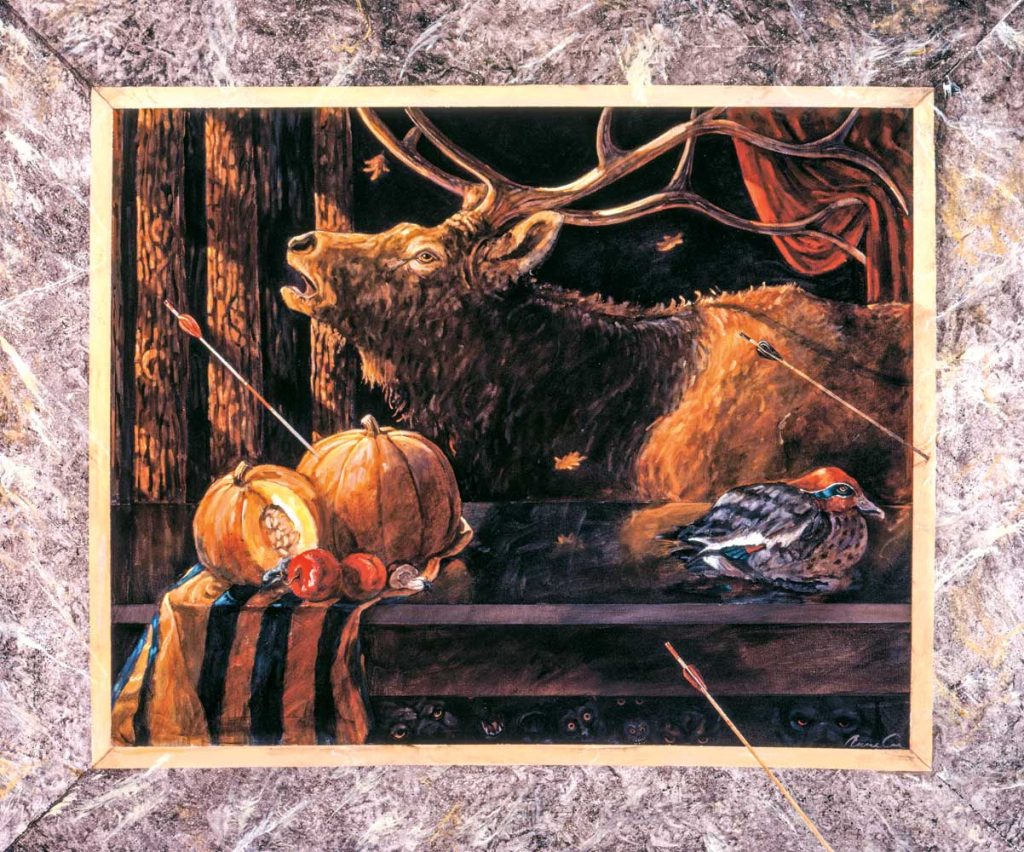
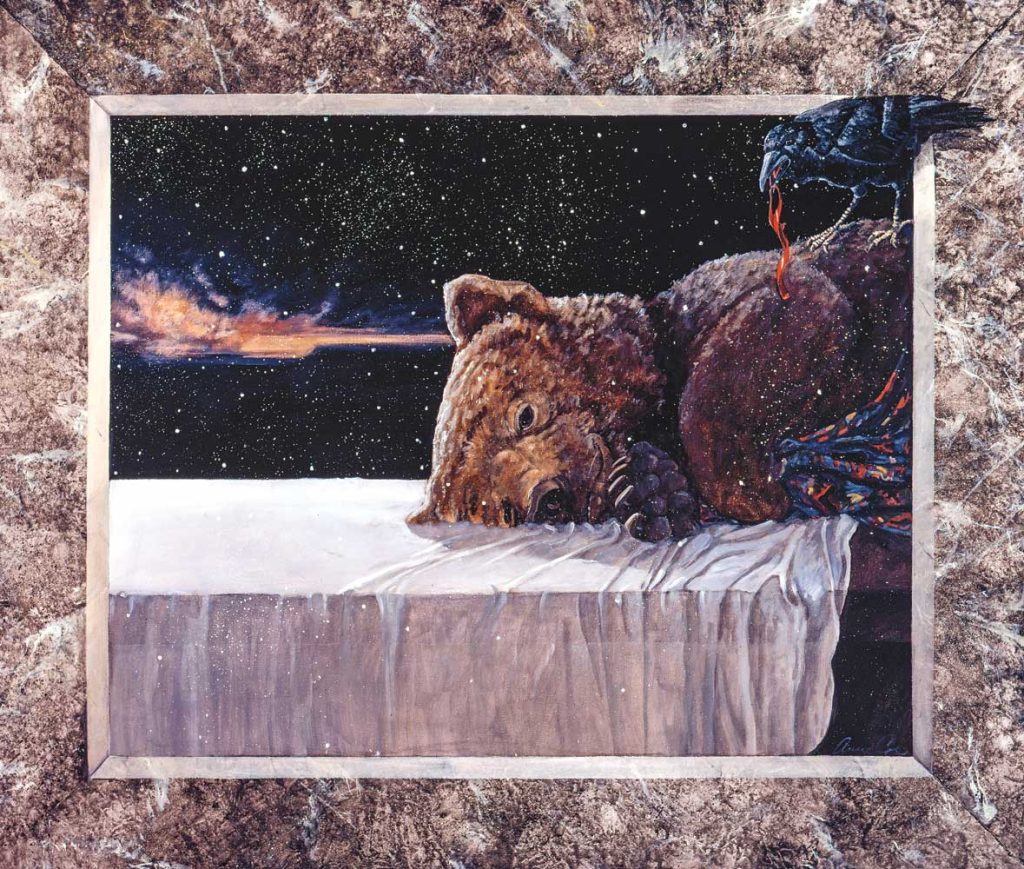
Still Life—Winter is the most somber of the group. Within an opaque night of snowflakes falling and the last rays of sunlight sinking, a dark bear rests on a table covered in white satin cloth while a black raven, holding a red ribbon in its beak, rests on its back.
44 x 52”, Acrylic on Canvas
Still Life–Spring shows signs of a new day. A crowing rooster positions itself on top of a ram that lies in repose with a pair of electric shears nearby, indicating the sacrifice of its fleece for the comfort of humans.
44 x 52”, Acrylic on Canvas
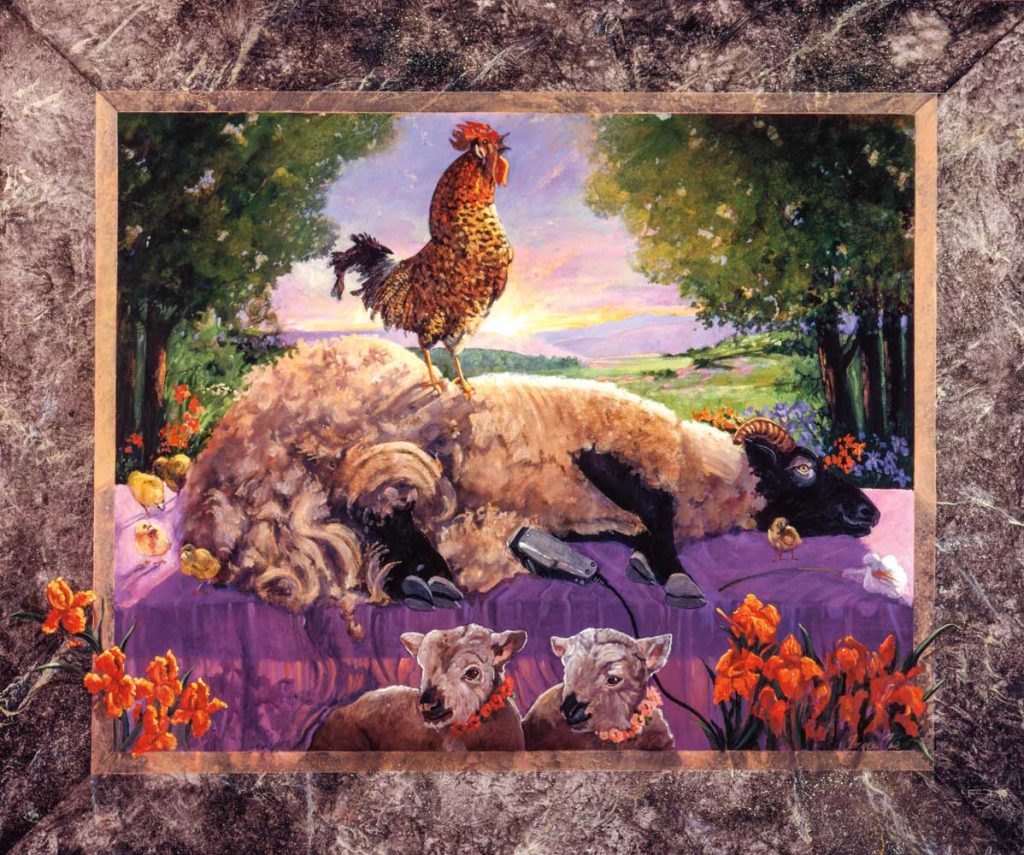
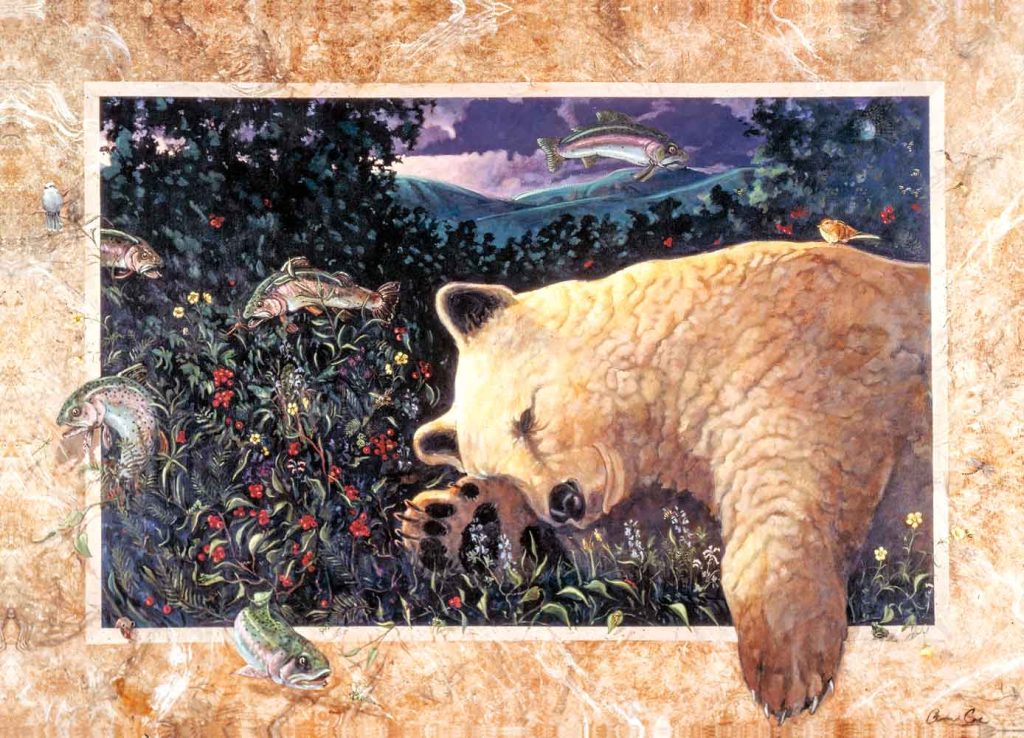
In a return to her familiar bear imagery, The Spirit Bear, 1999, reveals a large polar bear sleeping with a smile on his face in a berry and blossom nocturnal scene, while trout glide throughout the composition catching dragonflies and other insects.
50 x 70”, Acrylic on Canvas
In a distinctly darker palette and looser style, she created Grief and Transcendence, 2002, a portrait of a large black bear comforting a red, curly-haired girl in its embrace as she looks out to the viewer.
40 x 30”, Acrylic on Canvas
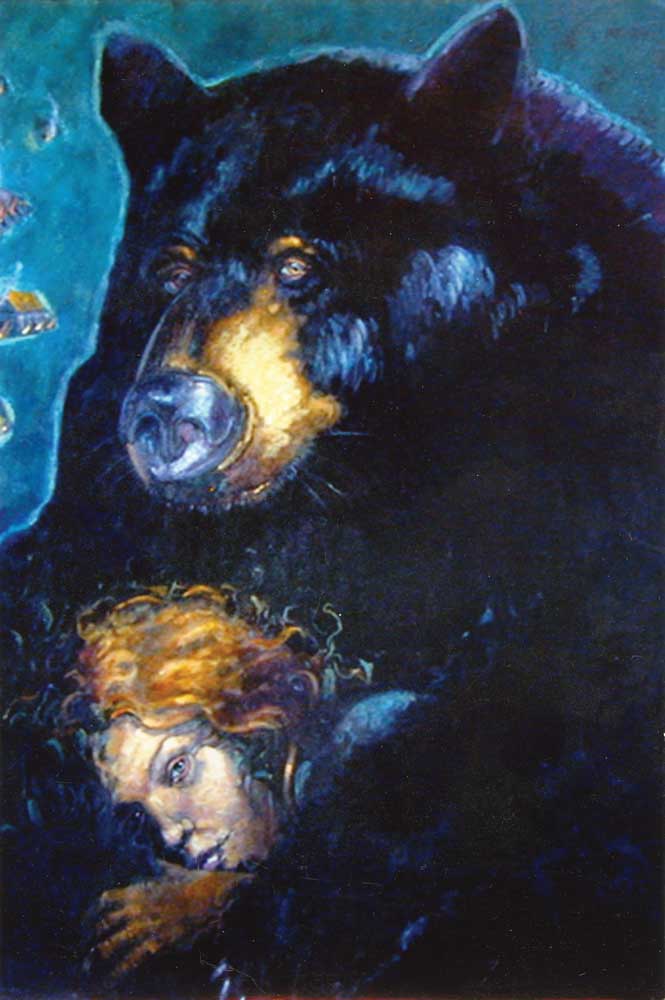
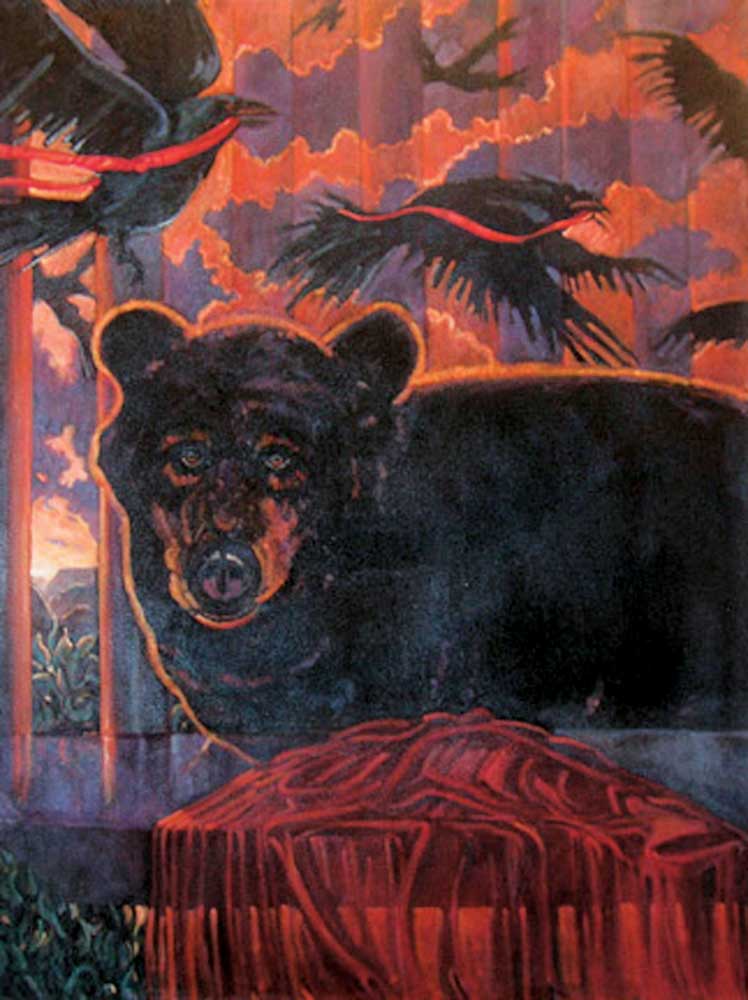
Red Sky at Mourning, 2002, a bear with a soft orange glow stands before a red drape that cascades over a circular object like a shroud or altar while ravens holding red ribbons in their beaks fly overhead in a cloud-filled sky at sunset.
40 x 30”, Acrylic on Canvas
Took the Chevy to the Levy, 2007, is a classic example of a Coe self-portrait, asserting herself as a woman in control. In this animated painting, a big red vintage Chevrolet convertible barrels forward, appearing to enter the viewer’s space beyond the faux wood frame adorned with ranch brands.
40 x 45”, Acrylic on Canvas

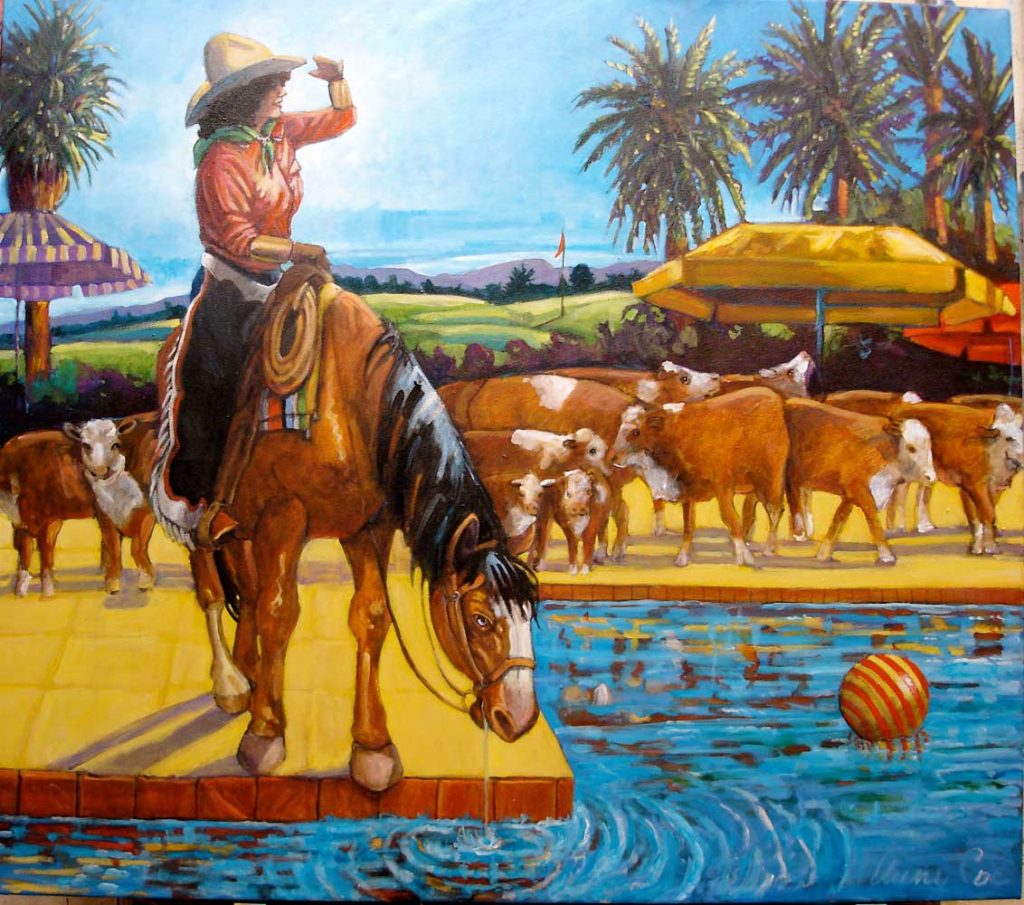
Addressing yet another version of her ongoing cowgirl series, she painted The New Watering Hole, 2010, an upbeat mix of nostalgia and perhaps a sly nod to the wealthy patrons whose homes are adorned with her work.
42 x 48”, Acrylic on Canvas
Topo Magic, 2013, was inspired by the topographical maps that she and her husband Sid poured over when hiking in the Tonto National Forest.
450 x 36’, Terrazzo Floor
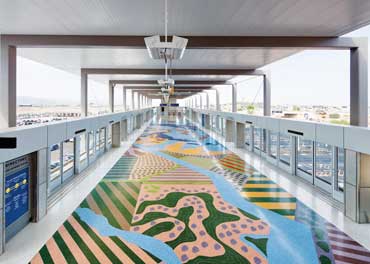
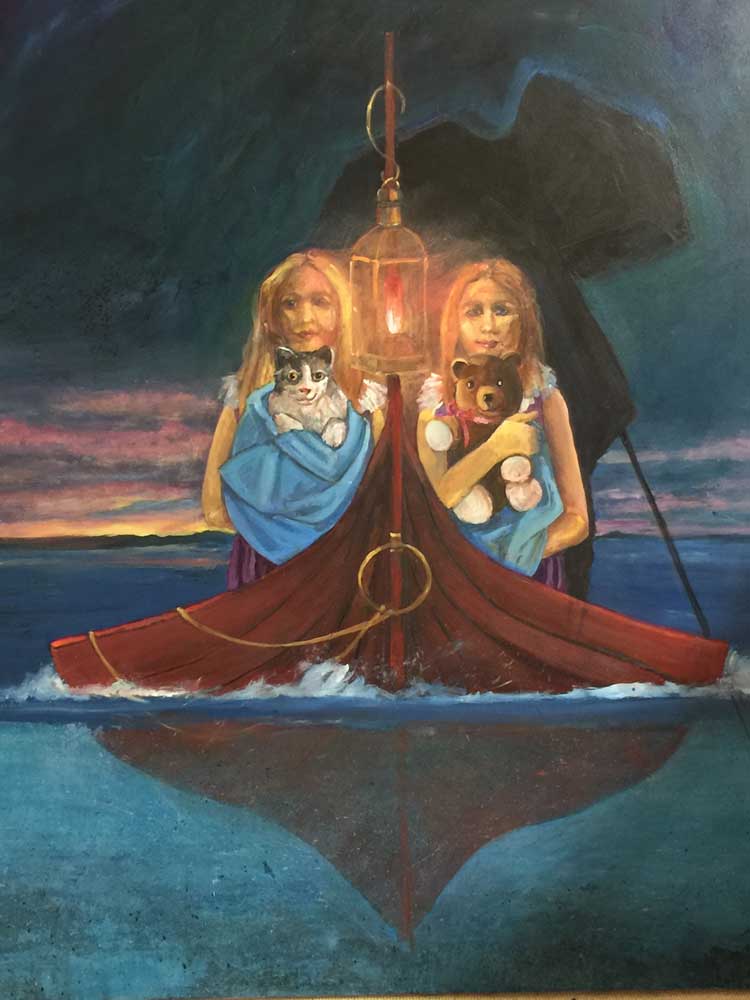
One departure from Coe’s tightly controlled, colorful allegories during this time can be seen in Tickets with Charon, 2017. In this nocturnal scene, two young women, one blonde and one redhead, representing archetypes, sit peacefully in what appears to be an ancient boat, steered by an unrecognizable figure shrouded in a dark cloak.
50 x 65”, Acrylic on Canvas
Anne Coe Paintings at a Glance



